#i made this post 22 Feb 2020 when he actually made these stories
Text









Simu Liu and his Stock Photos
#i made this post 22 Feb 2020 when he actually made these stories#cause this was just too funny#and i figured i would schedule it to post after shang chi came out cause more people would know him then#simu liu#shang-chi#shang chi#marvel#mcu#disney#stock photos
38K notes
·
View notes
Text
French Musical Recommendations/review (Part 2)
I should have mentioned in part 1 but I don't speak French (well a bit but not enough to understand the lyrics unless I’m reading it or something) so if the lyrics aren’t that good my bad I honestly wouldn’t know,
Also this is in no particular order, I don't think all the shows mentioned in part 1 are better than the ones mentioned here, there will be a part 3 at some point
1789 Les amantes de la Bastille: I think this may be my second or third (ties with Mozart) favourite French musical based solely on soundtrack, it’s about the siege of the Bastille and the days leading up to it with a focus on two lovers Ronan a revolutionary and Olympe Marie Antoinette’s children’s governess (the actress who played Olympe was also Guinevere in roi Arthur musical), my favourite songs are “Sur ma peau” and “La rue nous apparent” it is available in full on YouTube, IMPORTANT: This show has two endings, I don’t want to spoil so perhaps skip what I’m about to write though I will try to be vague: the scene before the song “fixe” at the end, the two characters switch place mattering on which version your watching, one version was done towards the start of the run and late 2013 they seemed to have made the change, the full version uploaded and the dvd have the original ending (I personally prefer the original but the other is not bad as well). also in 2012 when the show was staring with the showcase costumes are really different and you’ll find Ronan is played by Matthieu Carnot who plays Lazare in the full production later on instead because he had vocal issues resulting in getting replaced and given a more minor role (I think he’s great in his new role though, “Maniaque” is a bop)
Non-music: I have yet to see it in full but from clips the lighting is great and really adds to the songs and emotions, the story is pretty straightforward but nice, and the choreography is good from what I’ve seen, also for a “historical” show the costumes aren’t that bad, I would assume not accurate but a good balance of inaccurate and historical looking enough
Japanese Toho ver. (1789 バスティーユの恋人たち) 2016 clips are available on YouTube, the costumes in this version is fun, it’s non-replica but they really went off on Olympe’s costume, I will be honest a little bit sad about Ronan’s yellow jacket being replaced with a dark blue, also one of the Ronan actors (Olympe, Ronan and Marie-Antoinette are double casted) looks too old, especially compared to other Ronan actor who really has the young energetic vibe about him (though if memory serves me correctly his sur ma peau was strangely annoying to listen to)
Takarazuka ver. 2015, clips are available on YouTube if Japanese title along with “宝塚“ is added in search
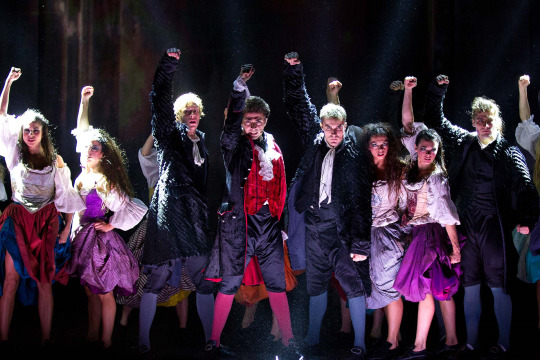
Notre-Dame de Paris: a musical based on Victor Hugo’s novel of the same name, it is different from the Disney musical, this is another popular French show, if you like Romeo et Juliette you’ll probably like this, it can found in full on YouTube along with different translations/adaptions, I won’t go to in depth on different version on here like I did for R+J but if your interested the Wikipedia page is quite detailed and can tell you about all the casts and cast recording available, I have yet to watch it in full but so far I think Belle and Le temps des cathédrales are my favourite songs (quite basic I know), it’s one of those shows you can’t go wrong with, from the parts I’ve watched and listened I think it could become one of my favourite shows
Non music: From the bits I’ve seen the wall backdrop is really cool, It has nooks and platforms that appear and disappear and it’s just really cool looking, WARNING, this is a bit of the spoiler so maybe don't read what I’m about to write but if you’ve read the book its not that much of a spoiler but there is a hanging scene at the end so if that imagery is something your sensitive to please be wary, it’s at the end (on the YouTube video of the full original show its from 2:03:42-2:03:54)
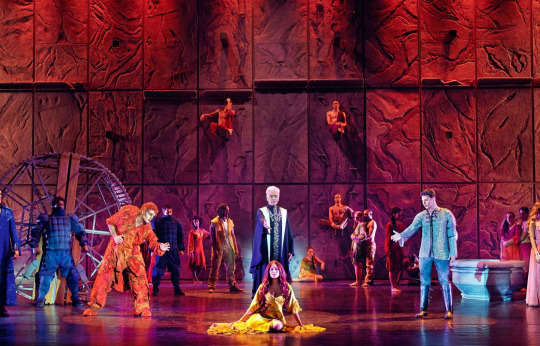
Don Juan: I love this show (I strangely found parts funny and a bit cheesy which is why I liked it), It’s pretty much about a man Don Juan who is a know heartbreaker who is only into sex drinking and having fun but no love, he then falls in love with a woman, shocker, and conflicts arise from there, honestly I don’t see a lot of content for this show but I think it’s fun, the dancing is primarily flamenco (music is heavily inspired by the dance as well) and it’s impressive, the singing is great, the full show is available on YouTube, my favourite songs are probably “Les fleurs du mal” and “Jalousie,” It opened in Montreal originally then went to Paris, the full show is available on YouTube (I think the Paris version) and there is also a full 3 and half hour behind the scenes video of the Paris production online, from what I can tell up till the symphony version of 2019 Don Juan and his love Maria has been consistently played by Jean-François Breau and Marie-Ève Janvier (obviously there were understudies and such) the actors are also married/were dating during the show which adds to it when you see them perform together
Non-Music: a character described with black hair in the song chorus is blonde/brunette and I thought that was hilarious, some strange choreography with Don Juan especially in Jalousie, he walks up and down stage and it’s awkward, aside from weird parts in general the costumes are ok (gets better in later productions), the set is plain but with some fun props, I think the dancing is probably one of the highlights along with the live band present on stage for certain songs (photo from Quebec 2013 production)
Don Juan (Théâtre St-Denis) 2004 Montreal, also had Canada tour after its Montreal premier in Feb.
France Tour 2005 Palais des Congrès à Paris performance recording and behind the scenes is available on YouTube
Korean Tour 2006, the French cast touring, non-costume concert versions and actual performance clips are available on Youtube
Korean Cast, 2009 (March~) (뮤지컬 돈 주앙) separate from the tour which was the French cast touring this is an all Korean cast, act 1 and 2 can be found on YouTube (video called “돈쥬앙 1막“ and “돈쥬앙 2막“) though it seems to cut around so It’s like a pieced together version of the acts, other clips are also available, it is a replica production
2012 revival Montreal, from what I read it only had 10 performances? and with it released a cd with new recordings, “nous on veut de l'amour“ and “L'amour Est Plus Fort“
Grand Théâtre de Québec 2013 (August 9-18), you could call this a continuation to the revival in Montreal
Takarazuka ver. 2016 (June+July) (ドン・ジュアン) the page is still up on the takarazuka website for this production, there’s a ad with clips from the show available on niconico (should come up if you search the title in jp and add takarazuka in jp) also this version Don Juan is strangely more touchy with his friend, not mad guess it adds a new tension to the plot, non replica production though it is quite similar to the French one, they don’t stray too far
Don Juan Symphonique 2019 (Feb 12-16): At the Montreal Symphony House they had a concert version with the original cast (or at least the original Don Juan and Maria), along with the OSM (Orchestre Symphonique de Montréal)
Japanese ver. 2019 (August/September + December) it’s non-replica, there’s a trailer for it online but it only features Don Juan, I found blog posts about it but currently while I write this it’s late so perhaps I’ll update with more info later, maybe not
Moscow Concert 2020 (March 17-22) (Дон Жуан or Don Juan) This is still in French with a French cast but this time the leads are no longer the original, Laurent Ban is now Don Juan, supposedly according to a Russian video it was meant to go on tour after Moscow (State Kremlin Palace) but I’m assuming the issue with the virus changed plans, I’m surprised they were going to go on world tour I honestly think it’s not true, the interview with cast can be found on YouTube with bits of songs, however the Russian concert advertisement is only a recording from the 2005 French, from what I can tell it is a replica, I believe it was cancelled before the premier due to Covid-19
The research for this show took me all day, maybe if I was fluent in French it would have been faster, if I’m wrong in parts feel free to comment and correct me and I’ll edit it

Les Trois Mousquetaires: Not to be mistaken with the Broadway/Westend show of the same name and base material from 1928 with the revival in the 80′s or the other three musketeer musical at the North Shore theatre in 2007 (the one with Aaron Tveit and Kevyn Morrow), or the other musical by George Stiles and Paul Leigh, this is an entirely separate 2016-2017 musical that follows the general plot of the literature it’s based on though simplified, it’s ok, not great but not the worst, I probably would rank it lower than roi Arthur, I will admit I haven’t listened to the full show, it’s quite catchy, my favourite song so far is probably “Je t’aime c’est tout,” there is a showcase concert in full, music videos and official soundtracks available on YouTube but I would advise checking out the live versions, the ensemble backing parts are really great and they get cut out in the recording versions which really cheapens the songs for me, In general ok show, really not the best but has its highlights (like the four lads relationship is fun to watch, dancing is great, singing is good),
Non-Music: Athos the oldest of the 3 musketeers is actually the youngest actor though he is a few year older than the D’Artagnan actor, It’s minor I guess but I didn’t realise who Athos was until looking up the cast list and was shocked, Also Athos really doesn’t sing because Brahim Zaibat who plays him is a dancer, despite this his dancing skills really add to the fight sequences making them very impressive and fun to watch, it’s more concerty in style and a bit interactive with the audience, from what I can tell the sets seem plain and the costumes are really awful (in my opinion) like Athos’ shirt is so revealing to the point he might as well not wear a shirt, also Constance’s outfit is just a no for me
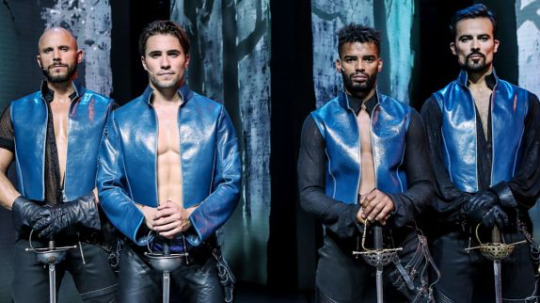
#1789 les amants de la bastille#notre dame de paris#les trois mousquetaires#the three musketeers#Don juan#musical theatre#French musicals#takarazuka#musicals#theatre#rambling
21 notes
·
View notes
Text
People often question dating apps and website and thereby have an assumption established in their minds that YOU CANNOT FIND ANYTHING SERIOUS HERE!
Well I’m here to tell you, maybe its not true. Maybe, I can change your mind about it.
Let’s take a walk down my memory lane and go back to December 2019.
Corona was still a small talk in the town and everyone was living their usual lives, at least here in India ( I don’t know much about other countries, so please don’t judge/hate me for that)
I started using Tinder and was meeting people, some were good, some were amazingly smart and with some I just could not connect and after one month of swiping left and right I matched with a guy. His profile seemed lively yet mysterious. I was drawn to him, we talked, we chatted, we videocalled each other and this went on for approximately a month and that’s when we decided to meet each other.
Feb 10 2020
It was the day when I first met him. He was probably the most beautiful person I have seen in my entire life, he was funny, smart and poetic and I was so attracted to him that I turned the blind eye to all the toxic shit he was doing to him, I failed to see that my face had lost the smile it used to have, I failed to feel what being playful feels like. He used to just talk to me whenever he wanted to sexted and apart from that he never showed any interest in any of my talks the way he used to do during the initial days, yet I was letting him trap me with him more and more.
And one day, he was gone! Just like that. 21 march 2020 was the day when he decided to call of everything we had, we shared in that past one month. He called me desperate and needy for attention and love. He made me feel guilty to feel the need of getting loved and cared for.
Which now I know is nothing I should be ashamed of. Everyone deserves to be loved and taken care of by the person they come home to everyday.
Fast forwarding to April End
22 April 2020
I was talking to a guy on Instagram (we origninally had matched on tinder and started talking but later on realised that he lives 580 kms away from my hometown) he told me about his choice of songs, his playlists, his weird fetishes, his fav snacks, his fav pieces of poetry and his list of cheesy lines from the most cheesy romantic movies/books.
Talking to him made me feel that as If i was talking to someone who is a south pole to my north pole of magnet. Totally Opposite!
We talked and talked for days about everything you can imagine.
Based on my previous experience, I chose not to trust him because it might end up in a few weeks and I might end up getting hurt again.
But things and conversations went on and on for a few days and again, chats turned into secret calls, midnight video calls, sending each other cheesy quotes and pins about “Best Friends”.
Fast forwarding to today. 18-02-2021
We have met each other for over 100 times. He is serving military so he comes to my house whenever he gets a leave. His and my family have the same hometown, he is just posted in a different city so has to live there.
We have met each other’s family and our families have met too!
We are planning our engagement and marriage next year.
I know it all sounds like a dream.
You might even say that this is happening way too fast.
Maybe it is, but I dont care, we dont care.
We love each other and are independent enough to sustain the responsibilities that come with a maggiage.
I found my soulmate in him. With him I can be my crazy, goofy self without being guilty of being needy of love. In fact with him I don’t even feel desperate or scared. With him I realised that you don’t fall in love. You fly high in love.
Love makes you a better human, happier human and most importantly it makes you strong. It gives you a hope for everything good that you deserve, when two people are in love, they live on, live in the form of the positive energies that they made with their love, with your presence and that those people leave behind after they are gone.
It’s beautiful
Apart from the fact that you can actually find your love on dating sites Tinder, I’m here to tell you that Long distance also work!
You just need to give your love and loyalty to that person. You have to work to gain their trust and they have to do the same.
If you guys remember I told you that he is posted in a city 580 kms away from my hometown, so yeah we are working hard everyday(in our individual lives as well our relationship)to get to the dream we have seen together.
At last I wanna say that
People often say that you cannot love someone until you learn to love yorself first, but his love made me forget what hating myself felt like.
So guys, believe in love. You might find it in the most unexpected manner. Iknow you will. And that is when you will not fall in love, You’ll fly in love. <3 <3
#love #lovestory #datingapps #tinder #storytime #midnightstory #happylovestory #story #india
1 note
·
View note
Text
The Truth Behind the COVID19 Crisis Hurts...
The White House and the CCP point their finger at each other for the COVID19 Crisis and pretending to be the innocent one, yet, none of them are able to confront the questions, facts and timeline listed below:
COVID19: Neither the CCP nor the WhiteHouse dare to say “Hold All Bloody Hands Accountable”…
The Source of the COVID19…
Who is Behind Wuhan Coronavirus Outbreak?! 武汉非典,难道是一场蓄谋的超限战?!
While whether Wuhan Corona Virus Out Break is a natural “virus out break” or a “premeditated attack” remains in question, how experts/elites, governments and authorities respond to the NOVEL corona-virus pandemic is stunning.
To no one’s surprise, the CCP suppressed the truth-telling whistle-blower, down-played the crisis, lied about the infection and death numbers and covered them up desperately which is exact what Steve Bannon expected, isn’t it, Steve Bannon?! After he and the other far-right warmongers exploited the CCP’s predictable bad handling, the White House repeated every single step that the CCP took when the hot spot of the COVID19 crisis shifted to the US.
Let the fact talks.
on March 23, 2020, as per Toutiao/今日头条, a media approved by the CCP, WuChang Funeral Home in #Wuhan announced that their ability to distribute ash urns for #coronavirus deaths is 500 per day and hopefully they can finish the distribution before April 4. That being said, the funeral home has at least 6,500 ash urns to deliver whereas Wuhan’s official deaths number for COVID19 is 2,531! Note that WuChang Funeral Home is one of at least 8 funeral homes in the city of Wuhan.

https://twitter.com/4OONHMEmTtmuKGP/status/1243234101462614016

https://twitter.com/detecti28108231/status/1245091066950320129
On the other hand, the America’s COVID19 data changed dramatically on the worldometers.info
This is what I found on March 21, 2020:
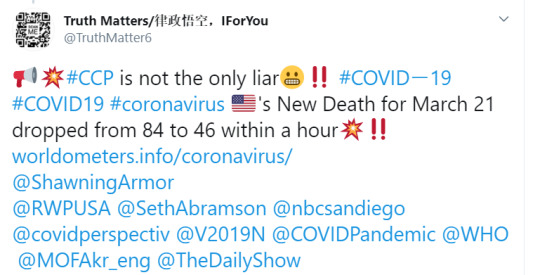

Note: The following links are re-posted because the original twitter account @TruthMatter6 is being suspended on March 31 for unknown reason, but you can imagine, the truth hurts.
https://twitter.com/detecti28108231/status/1245144421798236162
and on March 22, 2020:

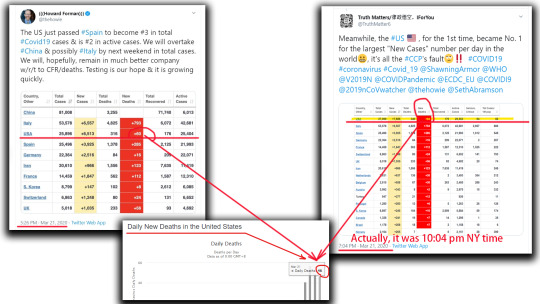
https://twitter.com/detecti28108231/status/1245142134983983105
It’s interesting to note that the daily deaths number reported by @AndyBiotech for March 21 is 79, close to the number I monitored (84) which was somehow replaced by 46.


https://www.worldometers.info/coronavirus/country/us/
It came to my attention that on March 29, the US’s daily deaths number dropped from 525 to 264:
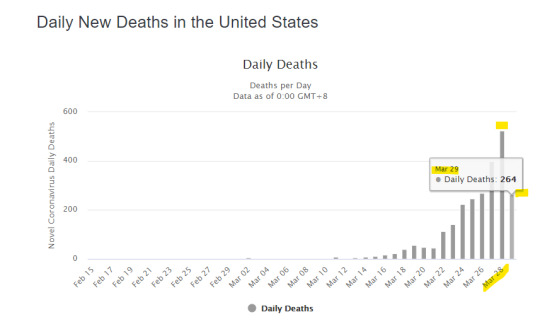
https://twitter.com/detecti28108231/status/1245085308816949251
After the suspicious “dramatic drop” of the death number, #Trump said on the next day, March 30, that "it is going away..." Co-incident"?

https://twitter.com/detecti28108231/status/1245147553966034944
Yet, it is NOT going away:
The US’s daily death number raised to 558 On March 30:

and it skyrocketed to 719 on March 31:

https://twitter.com/detecti28108231/status/1245148984936710144
https://www.worldometers.info/coronavirus/
WHO, the World Health Organization, who is supposed to put the public health of the whole world on 1st priority in a prudent and diligent manner, said on Jan. 31 that “the emergence of a previously unknown pathogen... has been met by an unprecedented response.” and that “new coronavirus person-to-person transmission outside of China has been limited”... we all know that it’s NOT true.

https://twitter.com/detecti28108231/status/1245086581230374912
As for whether COVID19 is airborne or not, on March 17, 2020, the U.S. Department of Health & Human Services published an article, saying“ the virus that causes coronavirus disease 2019 (COVID-19) is stable for several hours to days in aerosols and on surfaces, according to a new study from National Institutes of Health, CDC, UCLA and Princeton University scientists in The New England Journal of Medicine.”

https://www.nih.gov/news-events/news-releases/new-coronavirus-stable-hours-surfaces
Further more, South China Morning Post reported on March 9, 2020 a research that detailed how passengers contracted COVID19 by a virus carrier 4.5 m away from them on a bus.

https://www.scmp.com/news/china/science/article/3074351/coronavirus-can-travel-twice-far-official-safe-distance-and-stay
On March 26, Medium published a study supporting also the aerosol transmission theory.

https://medium.com/@Cancerwarrior/covid-19-why-we-should-all-wear-masks-there-is-new-scientific-rationale-280e08ceee71
Despite all of the fact-based studies, WHO arbitrarily concluded on March 28 that “COVID19 is NOT airborne”. I recall Dr. Michelle Au @AuforGA said "the history of Public Health is a story of prevention.” I am a Paralegal in Quebec, not a medical professional, but I believe the idea behind the public health prevention is similar to the public security protection: we don’t take any chance and we shall alarm even if the risk is uncertain or low, at least, we don’t go to the opposite and deny the possible risk, in my opinion.

https://twitter.com/AuforGA/status/1242158534646738944
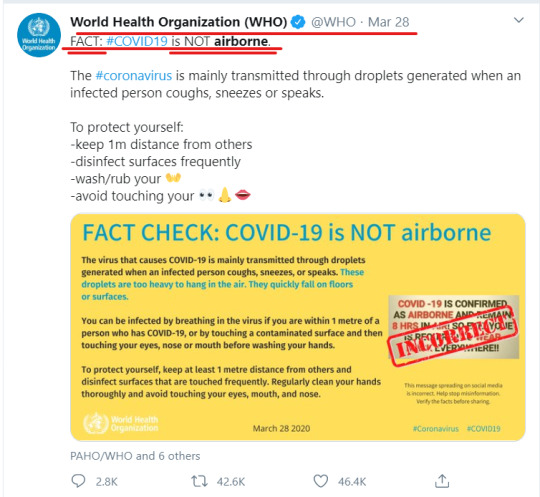
https://twitter.com/WHO/status/1243972193169616898
Meanwhile, Dr. Tedros @DrTedros is caught saying “this (COVID19) is airborne. It’s more contagious.” on Feb. 11, 2020!

https://twitter.com/surveilz/status/1245284096047304704
Speaking of Canada, truth be told, PM Trudeau’s administration did react in a timely fashion to my warning, may be, to Trump’s travel ban to Europe:

As the result, Canada’s immediate reaction made a big difference between Canada and the UK for the COVID19: as of March 31, the UK has 25,150 infection cases whereas Canada has 8,612; the UK has 1,789 deaths whereas Canada has 101 deaths.
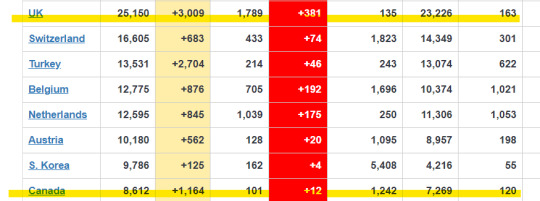
https://www.worldometers.info/coronavirus/
Nevertheless, the recent development of the COVID19 in Canada concerned me a lot. After I questioned Dr. Theresa Tam, the Chief Public Health Officer of Canada, if she was down-playing the COVID19 crisis, my twitter account @TruthMatter6 was blocked by the official twitter account of Ottawa Public Health. When many people raised the asymptomatic transmission issue of the COVID19 pandemic, she was still calling people to wash hands without paying any attention to the probably major killing factor of the pandemic.

Click to enlarge the image
On March 28, Dr. Tam posted a report that shows the infection cases number was going down, but I noticed that the chart does not include March 27 and 28 and the infection cases number was actually going up since March 25, according to data provided by Worldometer!
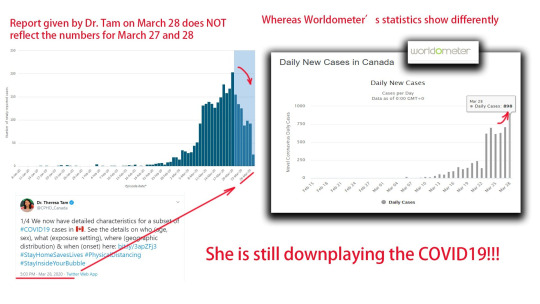
Click to enlarge the image
https://twitter.com/detecti28108231/status/1245082081782370304
https://www.worldometers.info/coronavirus/
For the last few weeks, what I tweeted most is “I told you so”.

https://twitter.com/NGL97230373/status/1243853370747531269
What You Don’t Know About the Novel Corona Virus- Messages/Info. From #Wuhan
Since the end of Feb., I’ve been collecting, verifying, translating and raising alarm about key issues I figured out. For example, I warned on Feb. 21 that many positive cases found in Wuhan are from the “recovered/discharged patients.

https://twitter.com/caolei1/status/1230487450209751040
This finding is later on supported by new findings and medical opinion from doctors in China. They believe that up to now, there is no totally recovered case from COVID19 and the corona virus may remain in the human body under control but it can recur in certain circumstances.

https://twitter.com/detecti28108231/status/1245114946377170944
The positive case found in “recovered” patients may also explain why an infected doctor used a "recovered" person's plasma for treatment but it didn't work, he passed away. Doesn’t it make the challenge of vaccine even harder to meet?

https://twitter.com/Onebtcer/status/1230523499636088833
Facing the global war-fare scale pandemic, time matters to billions of people’s life or death. As a Paralegal in Quebec and a Chinese who has long time been profiled and labeled, I’ve been doing my best to contribute to the anti-virus fight. Unfortunately, what I’ve experienced is stunning. Yes, I am not a medical professional, but to the west, the big data about the COVID19 has already been built in China and because of the language barrier, the west don’t know what China has already known. I tried to overcome the barrier with evidence-based facts, yet, the ego, the bureaucratic arrogance, the bias and the suppression is even more horrible.
My twitter account @TruthMatter6 is being suspended today. Can any one tell me why?
Read more:
COVID19: WhiteHouse or the CCP?
COVID—19: What did White House Fail to Protect American People?
COVID19: Neither the CCP nor the WhiteHouse dare to say “Hold All Bloody Hands Accountable”…
CCP’s Ruling Theory
What May Be the CCP’s Next Move?
0 notes
Text
What Would Happen if Trump Refused to Leave Office?
A peaceful transfer of power is necessary for American democracy to survive.
By Barbara McQuade | Published February 22, 2020 7:00 AM ET | The Atlantic Magazine | Posted Feb 22, 2020
If Donald Trump is defeated in November 2020, his presidency will end on January 20, 2021. If he is reelected, then, barring other circumstances such as removal from office, his administration will terminate on the same day in 2025. In either of these scenarios, Trump would cease to be president immediately upon the expiration of his term. But what if he won’t leave the White House?
The American Constitution spells out how the transfer of power is supposed to work. Article II provides that the president “shall hold his office for the term of four years.” The 20th Amendment says that the president’s and vice president’s terms “shall end at noon on the 20th day of January … and the terms of their successors shall then begin.” Of course, a president may be reelected to a second four-year term, but under the 22nd Amendment, “no person shall be elected to the office of president more than twice.”
[ READ BELOW Read: Trump’s second Term]
For nearly 250 years, presidents have respected the law. Even when electoral defeat has been unexpected and ignominious, presidents have passed the baton without acrimony. In a sense, perhaps this is the central achievement of the American system: to have transferred power peacefully from one leader to the next, without heredity to guide the way.
That a president would defy the results of an election has long been unthinkable; it is now, if not an actual possibility, at the very least something Trump’s supporters joke about. As the former Arkansas Governor Mike Huckabee tweeted, President Trump “will be eligible for a 3rd term due to the illegal attempts by Comey, Dems, and media , et al attempting to oust him as @POTUS so that’s why I was named to head up the 2024 re-election.” A good troll though it may have been, Huckabee is not the first person to suggest that Trump might not leave when his presidency ends.
In May, the faith leader Jerry Falwell Jr. tweeted an apparent reference to the completed investigation of Special Counsel Robert Mueller into Russian election interference. “I now support reparations,” he wrote. “Trump should have 2 yrs added to his 1st term as pay back for time stolen by this corrupt failed coup.” Trump retweeted Falwell’s post.
One of Trump’s former confidants, Michael Cohen, has suggested that Trump won’t leave. In his congressional testimony before heading to prison, Trump’s former attorney said, “Given my experience working for Mr. Trump, I fear that if he loses the election in 2020, there will never be a peaceful transition of power.”
Trump himself has joked about staying in office beyond his term, and even for life. In December, Trump told a crowd at a Pennsylvania rally that he will leave office in “five years, nine years, 13 years, 17 years, 21 years, 25 years, 29 years …” He added that he was joking to drive the media “totally crazy.” Just a few days earlier, Trump had alluded to his critics in a speech, “A lot of them say, ‘You know he’s not leaving’ … So now we have to start thinking about that because it’s not a bad idea.” This is how propaganda works. Say something outrageous often enough and soon it no longer sounds shocking.
Refusal to leave office is rare, but not unheard of. In the past decade, presidents in democracies such as Moldova, Sri Lanka, the Democratic Republic of Congo, and Gambia have refused to leave office, sometimes leading to bloodshed. In 2016, Joseph Kabila decided not to step down after three five-year terms as the president of Congo, announcing that he would delay the election for two years so that a census could be conducted. His decision was met with mass protests in which 50 people were killed by government security forces. Still, he followed through and an election took place in 2018. He left office thereafter.
Elected officials in the U.S. have also refused to step down, albeit from lower offices than the presidency. In 1874, a Texas governor locked himself in the basement of the state capitol building after losing his reelection bid. The saga began when Republican Governor Edmund J. Davis lost the 1873 election by a resounding 2-to-1 ratio to his Democratic challenger, Richard Coke, and claimed that the election had been tainted with fraud and intimidation. A court case made its way to the state’s supreme court. All three justices, each of whom had been appointed by the incumbent Davis, ruled that the election was unconstitutional and invalid. Democrats called upon the public to disregard the court’s decision, and proceeded with plans for Coke’s inauguration. On January 15, 1874, Coke arrived at the state capitol with a sheriff’s posse, and was sworn in to office while Davis barricaded himself downstairs with state troopers. The next day, Davis requested federal troops from President Ulysses S. Grant. Grant refused, and Davis finally stepped down three days later.
In 1946, Georgia endured the “Three Governors Crisis,” when the governor-elect died before taking office. Three men—the outgoing governor, the son of the governor-elect and the lieutenant governor-elect—each claimed a right to the office. The state assembly voted for the governor-elect’s son to take charge, but the outgoing governor refused to leave, so both men physically occupied the governor’s office. The outgoing governor yielded when the governor-elect’s son had the locks changed. The state supreme court finally decided in favor of the lieutenant governor-elect three months later.
The closest thing to a refusal to leave office that the U.S. presidency has experienced was Franklin D. Roosevelt’s break with tradition by seeking a third term. Roosevelt rejected the norm set by George Washington, and followed by successive presidents, to step down after two terms. FDR was elected to a third and even a fourth term, but concern about a permanent executive led to the ratification of the 22nd Amendment in 1951, limiting presidents to two terms.
If Trump were inclined to overstay his term, the levers of power work in favor of removal. Because the president immediately and automatically loses his constitutional authority upon expiration of his term or after removal through impeachment, he would lack the power to direct the U.S. Secret Service or other federal agents to protect him. He would likewise lose his power, as the commander in chief of the armed forces, to order a military response to defend him. In fact, the newly minted president would possess those presidential powers. If necessary, the successor could direct federal agents to forcibly remove Trump from the White House. Now a private citizen, Trump would no longer be immune from criminal prosecution, and could be arrested and charged with trespassing in the White House. While even former presidents enjoy Secret Service protection, agents presumably would not follow an illegal order to protect one from removal from office.
Although Trump’s remaining in office seems unlikely, a more frightening—and plausible—scenario would be if his defeat inspired extremist supporters to engage in violence. One could imagine a world in which Trump is defeated in the 2020 election, and he immediately begins tweeting that the election was rigged. Or consider the possibility, albeit remote, that a second-term Trump is removed from office through impeachment, and rails about his ouster as a coup. His message would be amplified by right-wing media. If his grievances hit home with even a few people inclined toward violence, deadly acts of violence, or even terrorist attacks against the new administration, could result.
Ultimately, the key to the peaceful transfer of power is the conduct of the outgoing leader himself. America has thus far been lucky in that regard. After voluntarily relinquishing the presidency after his second term, Washington took measures to demonstrate the peaceful transfer of power. He attended the inauguration of his successor, John Adams, and insisted on walking behind Adams after the ceremony to display his subservience to the new president. Through this example, the citizenry was able to accept that the power of the presidency now resided in its new occupant.
More recently, upon leaving office after a heated campaign, George H. W. Bush left behind a letter to welcome Bill Clinton into the White House on January 20, 1993. It concluded, “You will be our president when you read this note. I wish you well. I wish your family well. Your success now is our country’s success. I am rooting hard for you. Good luck.” Imagining such a gracious note from the current occupant of the White House to his successor is difficult.
But if Trump should fail in his final duty as president to transfer power peacefully, the nation’s laws, norms, and institutions will be responsible for carrying out the will of the electorate. Should those fail too, then the American experiment’s greatest achievement will come to a grinding halt, and with it the hope that a republic can ever be kept.
_____
This story is part of the project “The Battle for the Constitution,” in partnership with the National Constitution Center.
_____
BARBARA MCQUADE is a professor at the University of Michigan Law School. She was the U.S. attorney for the Eastern District of Michigan and co-chair of the Attorney General’s Subcommittee on Terrorism and National Security in the Obama administration.
*********
NOW WE KNOW WHAT KIND OF AUTHORITARIAN TRUMP ASPIRES TO BE.... Over the past week, Trump has showed his commitment to creating Kyiv-on-the-Potomac.
By Franklin Foer | Published February 14, 2020 | The Atlantic | Posted February 22, 2020 |
Donald Trump’s obsession with Ukrainian corruption turned out to be genuine: He wanted it thoroughly investigated—for the sake of its emulation. The diplomats who testified in front in Adam Schiff’s committee explained and exposed the Ukrainian justice system. Their descriptions may have been intended as an indictment of kleptocracy, but the president apparently regarded them as an instructional video on selective prosecution, the subversion of a neutral judiciary, and the punishment of whistle-blowers who expose corruption.
Over the course of Trump’s presidency, his critics have speculated about the model of illiberal democracy that he would adopt as his own. After the past week—which saw the firing of Lieutenant Colonel Alexander Vindman, the revocation of the Justice Department’s sentencing memo for Roger Stone, and Attorney General Bill Barr’s increasingly heavy-handed control of the investigations into his boss—there’s less doubt about the contours of the state Trump hopes to build. He’s creating Kyiv-on-the-Potomac.
The House Intelligence Committee narrative featured a villainous bureau in Kyiv called the Office of the Prosecutor General. On paper, this department is akin to America’s own Department of Justice, but in practice, it acted more like an auction house where top government lawyers would entertain bids from oligarchs. These prosecutors have been integral to the maintenance and perversion of the system. Oligarchs would abuse the office to bring cases against old enemies; they also used the office to punish critics of their corrupt practices. And, in the most extreme example, one Ukrainian president weaponized the office against his primary political opponent: He actually locked her up. (It was Paul Manafort’s job, as a consultant to that president, to justify the arrest to the rest of the world.)
The United States has tried to push Ukraine away from this corrupt system. When Joe Biden bragged about how he conditioned U.S. financial assistance on the firing of the prosecutor Viktor Shokin, he was boasting about a legitimate accomplishment. Thanks in part to his efforts, Ukraine’s judiciary moved toward a system more like our own—at least more like the system that existed before William Barr entered the Justice Department—where the state shows no favor to its friends and no punitive malice towards its enemies.
There’s an irony to this tale. Just as the United States was succeeding in pushing the Ukrainian judiciary in a more democratic direction, it began plundering Ukraine’s recent past, borrowing its worst practices. The corrupt prosecutors who were displaced in the course of reform have reemerged as the conspiratorial figures whispering in Rudy Giuliani’s ear, stoking unfounded theories about Burisma and Biden. They urged Trump to exact revenge against his enemies, with the same malevolent prosecutorial intent and flimsy evidence that they might themselves have deployed.
At the core of liberal democracy, especially as it evolved in the 20th century, is the notion that a swath of the state should be preserved as a neutral territory. One of the constraints on political power is a governmental structure that removes politics from important tasks. This commitment extended well beyond insulating the judicial system. The government installed a layer of experts and civil servants, who sat below political appointees. These are people like Alexander Vindman, who supply facts and dispassionate analysis. They are the technocrats, so maligned around the Western world these days. They tabulate the data about economic growth so that an administration can’t concoct self-serving statistics about employment and production. They process foreign intelligence so that sycophantic aides don’t simply manipulate briefings to confirm the policy biases of the commander in chief. And they exist as checks on the machinations of political appointees, sensitive to any attempts to corruptly distort the government for personal benefit.
Conservatives have long waged war on this neutral state. George W. Bush’s administration bulldozed the CIA when its bureaucracy objected to his Iraq policy; it trashed the EPA when officials there sought to provide assessments of the environmental impact of proposals. The problem with Trump is that he is even less sensitive to the idea of neutrality than were his predecessors. He’s incapable of self-control and incapable of distinguishing his self-interest from the common good. So with the ejection of Vindman and other events of this past week, it’s possible to see Trump finally making his move against the neutral state. By punishing whistle-blowers so ostentatiously, he’s disciplining the bureaucracy to accept his corruption. He’s instigating the Ukrainification of American government.
*********
Our Founders Didn’t Intend for Pardons to Work Like This
The Constitution allows the president to forgive any federal crime, but just because he can does not mean he should.
By Jeffrey Crouch, Assistant professor of American politics at American University | Published FEBRUARY 21, 2020 | The Atlantic | Posted February 22, 2020 |
On Tuesday, President Donald Trump commuted the sentence of Rod Blagojevich, the former Illinois governor and Celebrity Apprentice contestant who was imprisoned for trying to sell Barack Obama’s Senate seat. The president also pardoned the former San Francisco 49ers owner Edward DeBartolo Jr., the “junk-bond king” Michael Milken, and former NYPD Commissioner Bernard Kerik, among others. Each person had some connection to the president, a fact that the White House press announcement on the decisions made clear. Trump seems to view clemency as a way to reward celebrities and please his supporters.
The country’s Founders did not intend for the clemency power to be used as a prize. Article II of the Constitution allows the president to forgive any federal crime, but just because he can does not mean he should.
[ Quinta Jurecic: Trump’s unpardonable challenge to the Constitution]
The Founding Fathers had their own ideas about how the process should work; Alexander Hamilton provided the most famous rationales for the clemency power. In “Federalist No. 74,” he noted how the president must be able to make exceptions for “unfortunate guilt”; otherwise, the justice system would be “too sanguinary and cruel.” Additionally, Hamilton pointed out that presidents may need to use clemency to quell unrest or rebellion and thereby “restore the tranquillity of the commonwealth.”
President George Washington pardoned two men charged with treason after the Whiskey Rebellion. On December 8, 1795, in his annual address to Congress, he said he was motivated to both show mercy and serve the public good. Washington’s use of these dual rationales set the clemency standard for his successors. Going forward, one or both ideas have implicitly undergirded most of the roughly 30,000 individual clemency decisions that have been granted by presidents one through 44. Each rationale has also been featured in a Supreme Court case: United States v. Wilson described a pardon as an “act of grace,” and Biddle v. Perovich described the pardon power as “part of the Constitutional scheme” and characterized clemency as a decision to be guided by “public welfare.”
Using clemency to address a larger societal concern, Presidents Abraham Lincoln and Andrew Johnson offered forgiveness to entice the Confederates to rejoin the Union. Harry Truman named a panel to recommend amnesty for Selective Service Act offenders after World War II. Both Jimmy Carter and his predecessor, Gerald Ford, offered amnesty to Vietnam War–draft offenders.
Presidents have also granted pardons and commutations as “acts of mercy” to individuals—many anonymous—for a variety of federal offenses. Most recipients applied to the pardon attorney’s office within the Department of Justice and, months or years later, successfully received a pardon or sentence commutation. Recent examples include Olgen Williams, whom George W. Bush pardoned in 2002 for stealing money from the mail, and Charles Russell Cooper, a bootlegger pardoned by Bush in 2005. In 2017, Barack Obama pardoned Fred Elleston Hicks for illegal use of food stamps.
Not all presidents have followed these rationales, though. History also shows that presidents—particularly recent ones—have abused clemency for their own personal or political benefit. In 1992, George H. W. Bush pardoned several Iran-Contra figures, including former Reagan Defense Secretary Caspar Weinberger, effectively relieving Weinberger of the need to stand trial, a boon to Bush, who may have been called to testify. Bill Clinton offered clemency to members of the violent Puerto Rican nationalist organization FALN, a controversial decision that some said he made to gain Latino support for the political races of his wife and Vice President Al Gore. Right before he left office, Clinton pardoned Marc Rich, a fugitive from justice whose ex-wife was a large Clinton donor. George W. Bush commuted the sentence of I. Lewis “Scooter” Libby, sparing Vice President Dick Cheney’s former chief of staff a prison term. (Trump later pardoned Libby.) The presidents issued each of these clemency decisions after they were free from electoral consequences.
President Trump began by pardoning former Sheriff Joe Arpaio for criminal contempt of court, after Arpaio refused to stop police practices that amounted to racial profiling. Trump mentioned his intentions at a political rally before granting the pardon three days later. Since then, Trump hasn’t looked back. Along the way, he has favored a host of well-connected, famous, wealthy, or partisan figures for presidential mercy. To his credit, Trump has not hidden from the press, Congress, or other institutions when exercising clemency. He makes a decision and then takes the heat, often noting that his clemency grants counteract an “unfair” criminal-justice system.
Almost a year after Arpaio, Trump teased on Twitter a pardon for the conservative commentator Dinesh D’Souza, who had violated campaign-finance laws. He pardoned D’Souza that same day, and then made comments that shifted clemency speculation to the TV personality Martha Stewart and to Blagojevich.
Trump has also been swayed by celebrities. He commuted Alice Marie Johnson’s prison sentence after Kim Kardashian West visited the White House to advocate for her. He also pardoned the late African American boxer Jack Johnson in a grant pushed by the Rocky actor Sylvester Stallone.
The usual procedure for petitioning for a pardon or sentence commutation is far less showy than Trump’s current process. Typically, after waiting a minimum of five years, applicants go to the website of the pardon attorney; download, complete, and submit the appropriate form; and wait. After a lengthy review—sometimes years—the result is usually the same for everyone: a denial. George W. Bush granted only about 2 percent of petitions for a pardon or sentence commutation; Barack Obama granted 5.3 percent; and—as of February 7, 2020—Trump had granted less than 0.5 percent of clemency requests.
The former pardon attorney Margaret Love explains in her article “The Twilight of the Pardon Power” that one crucial reason so few clemency cases receive a positive recommendation is that “all but a handful of the individuals officially responsible for approving Justice Department clemency recommendations since 1983 have been former federal prosecutors.” In other words, because prosecutors in the pardon attorney’s office are reluctant to undo the work of their fellow prosecutors, presidents are rarely given a thumbs-up to pardon.
[ Garrett Epps: The self-pardoning president]
The traditional role of the pardon attorney has been basically abandoned by the Trump administration, after the office assisted presidents for more than a century. As The Washington Post reported earlier this month, “Former White House officials describe a freewheeling atmosphere in which staff members have fielded suggestions from Trump friends while sometimes throwing in their own recommendations.” Moreover, “all but five of the 24 people who have received clemency from Trump had a line into the White House or currency with his political base.”
Whether Trump is reaping significant personal benefits from his clemency decisions is unclear, but he does seem to enjoy the public’s reaction, even inviting two military clemency recipients onstage at a fundraiser late last year. With so many clemency grants to controversial figures like Arpaio, D’Souza, and now Blagojevich, he may be launching trial balloons to test public reaction to more serious pardons for his former associates, including Roger Stone, Paul Manafort, and Michael Flynn.
Along similar lines, Trump has twice tweeted about his understanding of the scope of the clemency power. In July 2017, he noted that he held “the complete power to pardon.” Roughly a year later, Trump tweeted that he had “the absolute right to PARDON myself.” Robert Mueller’s investigation and the impeachment trial are now both behind him. Still, it’s become apparent at this point in his presidency that Trump has used clemency to both gauge public opinion and stake out ground for a self-pardon, should he ever need one.
_____
This story is part of the project “The Battle for the Constitution,” in partnership with the National Constitution Center.
_____
JEFFREY CROUCH is an assistant professor of American politics at American University. He is the author of The Presidential Pardon Power and the editor of the journal Congress & the Presidency.
*********
WHAT DEMOCRATS AREN’T ADMITTING ABOUT TRUMP’S RECORD
The episodes in which critics’ predictions weren't borne out offer valuable lessons for Trump’s challengers, even if they still vigorously disagree with the moves the president has made.
By Uri Friedman | Published February 22, 2020 7:00 AM ET | The Atlantic | Posted February 22, 2020 |
It’s 2020, and America is embroiled in not one but two catastrophic wars: one with Iran that has sucked in the entire Middle East, and another halfway across the world in North Korea sparked by Kim Jong Un test-firing nuclear-capable missiles that could hit the United States. It’s all the worse since the U.S. is waging both wars without allies, all of which have abandoned Donald Trump because of his incessant bullying.
Fortunately, this isn’t where we find ourselves today, but it’s what the president’s critics have been warning could occur if he carries on with policies that have shattered decades of conventional U.S. policy making. It’s not as if their concerns have no factual basis. The Trump administration really did come to the brink of war with Iran and North Korea. In neither case are the underlying tensions that got them there anywhere near resolved. America’s alliances are indeed in flux. But the fact that this is not our reality in 2020 is just as instructive as the fact that it could have been.
This pattern has recurred on several occasions during the Trump era: The president’s detractors foretell doom caused by one of his decisions, only to be proved wrong, and then nobody acknowledges that they got it wrong or admits that Trump’s policies have had some advantages.
Of course, just because some of these doomsday scenarios haven’t yet materialized doesn’t mean that they won’t eventually. A number of Trump’s actions have already inflicted serious damage and could have corrosive consequences that will only become evident over time. In some cases, Trump seems to have simply been lucky. A number of warnings, moreover, have proved right.
Nevertheless, as American foreign policy comes under greater scrutiny as part of this year’s presidential campaign, the Democratic candidates risk losing credibility with voters and undermining their policy prescriptions if they don’t reckon with the moments when they said the sky was falling and it wasn’t. Why should a voter be convinced that returning to aspects of the pre-Trump status quo is necessarily a good thing when the people advocating for that inaccurately diagnosed the results of Trump’s defiance of convention? The episodes in which critics’ predictions weren't borne out offer valuable lessons for Trump’s challengers, even if they still vigorously disagree with the moves the president has made.
[ Read: The Sanders doctrine]
As Charles Dunlap Jr., the head of Duke University’s Center on Law, Ethics, and National Security, wrote for Just Security early in the Trump administration, Americans “need balance in our national security and foreign policy discussions before we don sackcloth and ashes and hoist our ‘The End is Near’ signs. True, we are in an era of change, which is what happens in democracies when a candidate runs on a platform of change and wins, and change can be disquieting to those who prefer the status quo. But how good was the status quo?”
Consider three emblematic episodes:
The War With Iran That Wasn’t
In the wee hours of January 2, shortly after news broke that Trump had killed the Iranian commander Qassem Soleimani in a drone strike, Twitter pulsed with anxiety about #WWIII.
Enter the Democratic candidates: Bernie Sanders warned that Trump had just placed the United States “on the path to another” endless war, one that could again “cost countless lives and trillions more dollars.” Joe Biden declared that Trump had “just tossed a stick of dynamite into a tinderbox,” potentially bringing America to “the brink of a major conflict across the Middle East.” The U.S. was perched precariously on that brink, Elizabeth Warren argued, “because a reckless president, his allies, and his administration have spent years pushing us here.”
The calamitous war they envisioned, however, has not come to pass. They were right, though, that there would be devastating consequences. Iran retaliated by firing missiles at a U.S. base in Iraq, leaving at least 109 American troops with traumatic brain injuries. The Iranians mistakenly downed a civilian airliner, killing its 176 passengers, and hostilities between Iran and the U.S. remain dangerously high. Tehran has cast off restrictions under the 2015 deal brokered by the Obama administration to constrain Iran’s nuclear program, though it hasn’t yet raced to build a bomb, as many of Trump’s critics predicted would happen when the president withdrew from the agreement in 2018. Had Trump stuck with the accord in the first place, Iran and the U.S. might never have found themselves on the precipice of war over Soleimani’s demise.
Nevertheless, Iran’s missile barrage was a relatively restrained response when measured against the blow of losing its most powerful military leader and the predictions made by Sanders, Biden, and Warren. Iranian officials thought “that after a series of escalatory [Iranian] military operations—the tanker attacks, the shooting down of an American drone, the Saudi oil strikes, rocket attacks on bases in Iraq by Iranian-backed militias—Mr. Trump would refrain from responding consequentially,” only to be shocked by Trump taking out Soleimani, The New York Times reported last week in a postmortem of the crisis. Trump’s decision, the paper noted, “might ultimately deter future Iranian aggression.” A former British diplomat similarly told my London colleague Tom McTague that the Soleimani strike opened up “the space for de-escalation” by scrambling the Iranian government’s “understanding of how the Americans might react in [the] future.”
Setting aside the vital question of whether Trump’s killing of Soleimani was legally justified or strategically wise (for candidates such as Sanders and Warren, the answer is unequivocally no), it’s worthwhile to investigate why Iran didn’t react the way so many assumed it would and what insights that yields for how the United States deals with adversaries. Trump, “accidentally or otherwise, has identified real problems, including Iran’s ability to act with relative impunity,” McTague concluded. The Soleimani incident also suggests that viewing every U.S. military action in the Middle East through the trauma of the Iraq War can distort our understanding of those events.
The War With North Korea That Wasn’t
Trump’s critics argued that war would break out as a result of the president’s assorted threats (unleashing “fire and fury,” totally destroying “Rocket Man”) to attack North Korea during his first year in office. After Trump engaged in a nuclear-button measuring contest with North Korea’s leader on Twitter, Biden argued that the United States was closer to a nuclear war with North Korea than it had ever been. Sanders and Warren helped introduce legislation to restrain Trump from going to war with North Korea. These critiques weren’t confined to the left. Republican Senator Bob Corker cautioned that Trump doesn’t realize that “we could be heading towards World War III with the kinds of comments that he’s making.”
North Korean officials probably didn’t interpret Trump’s remarks as a signal that war was imminent. But the bellicosity of the president and his advisers put the U.S. military on high alert, alarmed America’s ally South Korea, and increased the risk that the parties could stumble into conflict, just as the president’s critics had warned.
That bellicosity, though, was also productive in ways that Trump’s detractors rarely acknowledge. Nikki Haley, Trump’s former ambassador to the United Nations, told me that she leveraged her boss’s rhetoric and volatility to persuade China and Russia to support UN Security Council sanctions against North Korea, which helped pressure Kim into (thus far mostly fruitless) nuclear negotiations with the United States. Vincent Brooks, who commanded U.S. forces in South Korea from 2016 to 2018, told me that the president’s unpredictability, paired with new military maneuvers on the Korean peninsula, helped Brooks reestablish deterrence against North Korean provocations and create space for diplomacy. "Trying to bait a dictator who has nuclear weapons is not a way to advance diplomacy," Warren argued in 2017. According to two former Trump administration officials who were at the forefront of its North Korea policy during this period, however, it was one way to do so.
The lesson here isn’t exactly that future American presidents should bait nuclear-armed dictators, but rather that, in certain situations, unconventional behavior can unlock opportunities to achieve breakthroughs with enemies. Thae Yong Ho, one of the highest-ranking officials ever to defect from North Korea, told me that he thought Trump’s sharp break with the “very gentle” posture of past American presidents helped dissuade North Korea from escalating the nuclear crisis with the United States in late 2017.
The Very Anxious Allies That Remain Allies
Trump’s critics have likewise divined doom each time the president has raised questions about his commitment to defending U.S. allies and demanded huge hikes in their financial contributions to collective security. Biden, for example, has warned that if Trump is reelected, “NATO will fall apart.” Similar predictions have been made as Trump pushes for new arrangements in which Japan and South Korea would cover most of the costs of stationing U.S. troops in each country.
These alliances are indeed being tested more than they have been in decades, and all these partners are now engaged in more contingency planning for a world in which they can no longer depend on U.S. protection. But the fact that the alliances haven’t yet shattered—and by some measures, certain alliances have actually grown stronger during the Trump era—reveals two realities of America’s network of alliances that the next commander in chief will confront.
First, Trump’s tenure has underscored that the United States never really figured out its role in the world and national-security interests once the Cold War ended and its clout began to decline relative to that of rising powers. That debate is now under way in earnest, and U.S. allies are gradually grasping this and processing what it means for them.
Second, for all the upheaval of the Trump years, these partners have come to recognize that they ultimately don’t have attractive alternatives—teaming up with authoritarian powers such as China and Russia? Staking their security on a weak European Union?—to their alliance with the United States. Some allied leaders may not be especially enthused about collaborating with the U.S. these days, and their publics may be with them, but their national interests still dictate that they do. That means there’s more room to tackle sensitive issues such as burden-sharing and more resilience in the relationships than previous American presidents suspected. Kersti Kaljulaid, the president of Estonia, a NATO member bordering Russia and thus on the front line of fears about America’s wavering fidelity to the bloc, told me and my colleague Yara Bayoumy that it took Trump’s crass transactionalism (rather than Barack Obama and his predecessors asking “nicely”) to impress upon NATO members that they had to get serious about ramping up their own defense spending.
As Robert Blackwill of the Council on Foreign Relations noted in a 2019 assessment of Trump’s foreign policy—in which he memorably likened the president’s policies to “a large bowl of spaghetti bolognese dumped and spread on a white canvas”—many criticisms of the president’s conduct in the world are related to the manner in which he makes, announces, and explains decisions and to the policy incoherence within his administration. Rarely, however, is it acknowledged that “the president has disrupted a whole series of conventions in the international system, some of them undoubtedly needed.”
“Not a single U.S. politician,” Blackwill observed, “has a coherent and convincing set of policies to cope with this eroding world order, but Trump receives nearly all the slings and arrows.”
*********
TRUMP’S SECOND TERM.... It’s more likely than most people think—and compared with his first term, its effects would be far more durable.
By Paul Starr | MAY 2019 ISSUE | The Atlantic | Posted February 22, 2020 |
Of all the questions that will be answered by the 2020 election, one matters above the others: Is Trumpism a temporary aberration or a long-term phenomenon? Put another way: Will the changes brought about by Donald Trump and today’s Republican Party fade away, or will they become entrenched?
Trump’s reelection seems implausible to many people, as implausible as his election did before November 2016. But despite the scandals and chaos of his presidency, and despite his party’s midterm losses, he approaches 2020 with two factors in his favor. One is incumbency: Since 1980, voters have only once denied an incumbent a second term. The other is a relatively strong economy (at least as of now). Alan Abramowitz, a political scientist at Emory University who weights both of those factors heavily in his election-forecasting model, gives Trump close to an even chance of reelection, based on a projected 2 percent GDP growth rate for the first half of 2020.
So far, much of the concern about the long-term effects of Trump’s presidency has centered on his antidemocratic tendencies. But even if we take those off the table—even if we assume that Trump continues to be hemmed in by other parts of the government and by outside institutions, and that he governs no more effectively than he has until now—the impact of a second term would be more lasting than that of the first.
In normal politics, the policies adopted by a president and Congress may zig one way, and those of the next president and Congress may zag the other. The contending parties take our system’s rules as a given, and fight over what they understand to be reversible policies and power arrangements. But some situations are not like that; a zig one way makes it hard to zag back.
This is one of those moments. After four years as president, Trump will have made at least two Supreme Court appointments, signed into law tax cuts, and rolled back federal regulation of the environment and the economy. Whatever you think of these actions, many of them can probably be offset or entirely undone in the future. The effects of a full eight years of Trump will be much more difficult, if not impossible, to undo.
Three areas—climate change, the risk of a renewed global arms race, and control of the Supreme Court—illustrate the historic significance of the 2020 election. The first two problems will become much harder to address as time goes on. The third one stands to remake our constitutional democracy and undermine the capacity for future change.
In short, the biggest difference between electing Trump in 2016 and reelecting Trump in 2020 would be irreversibility. Climate policy is now the most obvious example. For a long time, even many of the people who acknowledged the reality of climate change thought of it as a slow process that did not demand immediate action. But today, amid extreme weather events and worsening scientific forecasts, the costs of our delay are clearly mounting, as are the associated dangers. To have a chance at keeping global warming below 1.5 degrees Celsius—the objective of the Paris climate agreement—the Intergovernmental Panel on Climate Change says that by 2030, CO2 emissions must drop some 45 percent from 2010 levels. Instead of declining, however, they are rising.
In his first term, Trump has announced plans to cancel existing climate reforms, such as higher fuel-efficiency standards and limits on emissions from new coal-fired power plants, and he has pledged to pull the United States out of the Paris Agreement. His reelection would put off a national commitment to decarbonization until at least the second half of the 2020s, while encouraging other countries to do nothing as well. And change that is delayed becomes more economically and politically difficult. According to the Global Carbon Project, if decarbonization had begun globally in 2000, an emissions reduction of about 2 percent a year would have been sufficient to stay below 2 degrees Celsius of warming. Now it will need to be approximately 5 percent a year. If we wait another decade, it will be about 9 percent. In the United States, the economic disruption and popular resistance sure to arise from such an abrupt transition may be more than our political system can bear. No one knows, moreover, when the world might hit irreversible tipping points such as the collapse of the West Antarctic Ice Sheet, which would likely doom us to a catastrophic sea-level rise.
The 2020 election will also determine whether the U.S. continues on a course that all but guarantees another kind of runaway global change—a stepped-up arms race, and with it a heightened risk of nuclear accidents and nuclear war. Trump’s “America first” doctrine, attacks on America’s alliances, and unilateral withdrawal from arms-control treaties have made the world far more dangerous. After pulling the United States out of the Iran nuclear agreement (in so doing, badly damaging America’s reputation as both an ally and a negotiating partner), Trump failed to secure from North Korea anything approaching the Iran deal’s terms, leaving Kim Jong Un not only unchecked but with increased international standing. Many world leaders are hoping that Trump’s presidency is a blip—that he will lose in 2020, and that his successor will renew America’s commitments to its allies and to the principles of multilateralism and nonproliferation. If he is reelected, however, several countries may opt to pursue nuclear weapons, especially those in regions that have relied on American security guarantees, such as the Middle East and Northeast Asia.
At stake is the global nonproliferation regime that the United States and other countries have maintained over the past several decades to persuade nonnuclear powers to stay that way. That this regime has largely succeeded is a tribute to a combination of tactics, including U.S. bilateral and alliance-based defense commitments to nonnuclear countries, punishments and incentives, and pledges by the U.S. and Russia—as the world’s leading nuclear powers—to make dramatic cuts to their own arsenals.
In his first term, Trump has begun to undermine the nonproliferation regime and dismantle the remaining arms-control treaties between Washington and Moscow. In October, he announced that the U.S. would withdraw from the Intermediate-Range Nuclear Forces (INF) Treaty signed in 1987 by Ronald Reagan and Mikhail Gorbachev. While the Russian violations of the treaty that Trump cited are inexcusable, he has made no effort to hold Russia to its obligations—to the contrary, by destroying the treaty, he has let Russia off the hook. What’s more, he has displayed no interest in extending New START, which since 2011 has limited the strategic nuclear arsenals of Russia and the United States. If the treaty is allowed to expire, 2021 will mark the first year since 1972 without a legally binding agreement in place to control and reduce the deadliest arsenals ever created.
The prospect of a new nuclear arms race is suddenly very real. With the end of verifiable limits on American and Russian nuclear weapons, both countries will lose the right to inspect each other’s arsenal, and will face greater uncertainty about each other’s capabilities and intentions. Already, rhetoric has taken an ominous turn: After Trump suspended U.S. participation in the INF Treaty on February 2, Vladimir Putin quickly followed suit and promised a “symmetrical response” to new American weapons. Trump replied a few days later in his State of the Union address, threatening to “outspend and out-innovate all others by far” in weapons development.
The treaties signed by the United States and Russia beginning in the 1980s have resulted in the elimination of nearly 90 percent of their nuclear weapons; the end of the Cold War seemed to confirm that those weapons had limited military utility. Now—as the U.S. and Russia abandon their commitment to arms control, and Trump’s “America first” approach causes countries such as Japan and Saudi Arabia to question the durability of U.S. security guarantees—the stage is being set for more states to go nuclear and for the U.S. and Russia to ramp up weapons development. This breathtaking historical reversal would, like global warming, likely feed on itself, becoming more and more difficult to undo.
Finally, a second term for Trump would entrench changes at home, perhaps the most durable of which involves the Supreme Court. With a full eight years, he would probably have the opportunity to replace two more justices: Ruth Bader Ginsburg will be 87 at the beginning of the next presidential term, and Stephen Breyer will be 82. Whether you regard the prospect of four Trump-appointed justices as a good or a bad thing will depend on your politics and preferences—but there is no denying that the impact on the nation’s highest court would be momentous.
Not since Richard Nixon has a president named four new Supreme Court justices, and not since Franklin D. Roosevelt has one had the opportunity to alter the Court’s ideological balance so decisively. In Nixon’s time, conservatives did not approach court vacancies with a clear conception of their judicial objectives or with carefully vetted candidates; both Nixon and Gerald Ford appointed justices who ended up on the Court’s liberal wing. Since then, however, the conservative movement has built a formidable legal network designed to ensure that future judicial vacancies would not be squandered.
The justices nominated by recent Republican presidents reflect this shift. But because the Court’s conservative majorities have remained slim, a series of Republican appointees—Sandra Day O’Connor, Anthony Kennedy, and most recently John Roberts—have, by occasionally breaking ranks, held the Court back from a full-scale reversal of liberal principles and precedents. With a 7–2 rather than a 5–4 majority, however, the Court’s conservatives could no longer be checked by a lone swing vote.
Much of the public discussion about the Court’s future focuses on Roe v. Wade and other decisions expanding rights, protecting free speech, or mandating separation of Church and state. Much less public attention has been paid to conservative activists’ interest in reversing precedents that since the New Deal era have enabled the federal government to regulate labor and the economy. In the late 19th and early 20th centuries, conservative justices regularly struck down laws and regulations such as limits on work hours. Only in 1937, after ruling major New Deal programs unconstitutional, did the Court uphold a state minimum-wage law. In the decades that followed, the Court invoked the Constitution’s commerce clause, which authorizes Congress to regulate interstate commerce, as the basis for upholding laws regulating virtually any activity affecting the economy. A great deal of federal law, from labor standards to the Civil Rights Act of 1964 to health and environmental regulation, rests on that foundation.
But the Court’s conservative majority has recently been chipping away at the expansive interpretation of the commerce clause, and some jurists on the right want to return to the pre-1937 era, thereby sharply limiting the government’s regulatory powers. In 2012, the Court’s five conservative justices held that the Affordable Care Act’s penalty for failing to obtain insurance—the so-called individual mandate—was not justified by the commerce clause. In a sweeping dissent from the majority’s opinion, four of those justices voted to strike down the entire ACA for that reason. The law survived only because the fifth conservative, Chief Justice Roberts, held that the mandate was a constitutional exercise of the government’s taxing power.
If the Court had included seven conservative justices in 2012, it would almost certainly have declared the ACA null and void. This is the fate awaiting much existing social and economic legislation and regulation if Trump is reelected. And that’s to say nothing of future legislation such as measures to limit climate change, which might well be struck down by a Court adhering to an originalist interpretation of our 18th-century Constitution.
Democracy is always a gamble, but ordinarily the stakes involve short-term wins and losses. Much more hangs in the balance next year.
With a second term, Trump’s presidency would go from an aberration to a turning point in American history. But it would not usher in an era marked by stability. The effects of climate change and the risks associated with another nuclear arms race are bound to be convulsive. And Trump’s reelection would leave the country contending with both dangers under the worst possible conditions, deeply alienated from friends abroad and deeply divided at home. The Supreme Court, furthermore, would be far out of line with public opinion and at the center of political conflict, much as the Court was in the 1930s before it relented on the key policies of the New Deal.
The choice Americans face in 2020 is one we will not get to make again. What remains to be seen is whether voters will grasp the stakes before them. In 2016, Hillary Clinton’s emails absorbed more media and public attention than any other issue. In 2018, Trump tried to focus attention on a ragtag caravan of a few thousand Central Americans approaching the southern border. That effort failed, but the master of distraction will be back at it next year. If we cannot focus on what matters, we may sleepwalk into a truly perilous future.
_____
PAUL STARR is a professor of sociology & public affairs at Princeton & winner of Pulitzer Prize for General Nonfiction. He is the author of Entrenchment: Wealth, Power & the Constitution of Democratic
Societies.
*********
#u.s. news#trump administration#politics#president donald trump#politics and government#trump scandals#trumpism#republican politics#donald trump#us politics#trump cult#trump crime family#trump crime syndicate#trump corruption#2020 candidates#2020 presidential election#2020 election#democratic party#democracy#democrats#top stories google news#nyt > top stories#top news#national news#national security
0 notes
Photo

New Post has been published on https://vacationsoup.com/?p=275494
[Duplicated:275491] Favorite Daytona 500 Thrills and Memories

What is your favorite Daytona 500 memory? Even non-race-car-fans have favorite Daytona 500 thrills and memories.

The Thunderbirds flyover as President Donald Trump, accompanied by first lady Melania Trump, stands during the national anthem before the start of the NASCAR Daytona 500 auto race at Daytona International Speedway, Sunday, Feb. 16, 2020, in Daytona Beach, Fla. (AP Photo/Alex Brandon)
Thunderbirds
Just prior to announcing the start of the race, the famous US Air Force Thunderbirds flyover the race track. Tucked 18 inches apart at 500 mph, the six F-16 falcons scream across the sky in their signature Delta formation above the World Center of Racing. Jaws drop in awe. American hearts swell with pride.

Danica Patrick, driver of the #7 GoDaddy Chevrolet, stands on the grid during qualifying for the Monster Energy NASCAR Cup Series Daytona 500 at Daytona International Speedway on February 11, 2018 in Daytona Beach, Florida. (Photo by Sarah Crabill/Getty Images)
DRIVERS START YOUR ENGINES
The anticipation and excitement builds and builds as the 101,000 fans await the famous words. Finally, after the famous words " DRIVERS START YOUR ENGINES", the thunderous roar of the 40 racing machines is visceral - you physically feel it. The crowd goes wild. A moment and a "feeling" not ever forgotten. The world famous words "Gentlemen Start Your Engines" is a trademark phrase owned by Indianapolis Speedway since 1995. The famous phrase at the beginning of Formula One and NASCAR races has been replaced by a more gender neutral phrase "Drivers Start Your Engines" since 2017. Ladies Janet Guthrie in 1977 (Formula One) and Danica Patrick in 2012 (NASCAR) became the first women drivers to compete at the top levels of racing.


Dale Sr and Dale Jr
Everyone knows the story of Dale Earnhardt and his son Dale Jr. Dale, the legendary #3, "The Intimidator", was a famous top driver , winning 69 Winston Cup races over his career until his horrific crash at age 49. . On the last lap of the Daytona 500 in 2001, he collided with two other cars and crashed into the wall of the 4th (final) turn. He died from head injuries. His son, Dale Jr, finished the race in second place, not knowing at the time of his father's fatal injuries. Dale Jr. continued racing to his own successful career, one of the most popular drivers ever. He won his second Daytona 500 ten years later. His fans appreciated his emotional courage in following in his father's footsteps while making his own mark, and dealing with the intrepidation he had to feel each time he raced that same 4th turn over his career. Another of Dale Sr.'s legacies, was the NASCAR organization's serious improvements made for driver safey after his death. The seatbelt and restraint harness systems were improved, and the tracks were upgraded with impact absorption barriers at key crash points. Of note, no driver has died during a NASAR race since that time.
https://youtu.be/Zfo88N2PFdc
Link to Video
1976 Final Two Laps of Daytona 500
Limping across the Finish Line
In 1976, Pearson and Petty crashed battling for the lead coming out of the fourth turn on the last lap of the Daytona 500. When both cars came to a rest, they had still not crossed the start/finish line. Petty’s car wouldn’t start but Pearson dumped the clutch and kept the car in neutral to slowly cross the finish line to capture the only Daytona 500 of his career. The finish was the slowest under green flag conditions in race history.

Crashes
The 2016 race was the only Daytona 500 since 2010 that did not have at least one wreck involving at least seven cars. The 2014 and 2017 races each had two wrecks with at least 10 cars each. There were 8 multi-car wrecks in the last three Daytona 500s — and 18 multi-car wrecks in the last nine Daytona 500s. In the final 10 scheduled laps of last year’s race, a wreck involving 21 cars unfolded, and the race was red-flagged — stopped. The race was restarted, and after one green-flag lap, there was a seven-car wreck, and the race was red-flagged again. Then there was an eight-car wreck. At speeds of 180-200 MPH (pole qualifier speeds) with inches separating the cars on a bumpy track, and drivers jockeying for position and drafting inches from the bumper in front of them - it is no wonder there are massive wrecks. As I write this today, we are waiting and hoping for a good outcome for Ryan Newman who wrecked and was seriously injured in the last lap of the race this year.
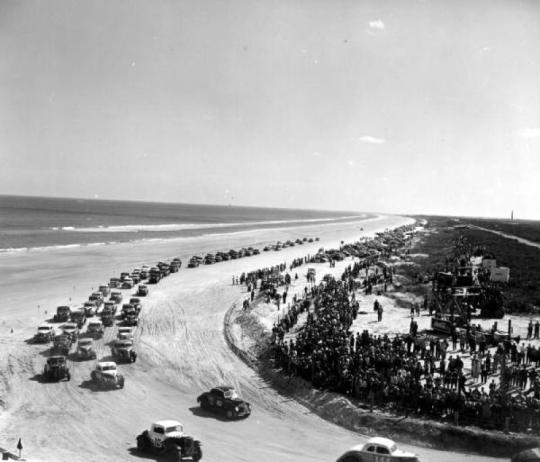
From Sand to Asphalt
Daytona Beach became the unofficial “Birthplace of Speed” in 1903 when two men argued over who had the fastest horseless carriage and decided things in a race on the white, hardpacked sand along the Atlantic Ocean. The speed competitions along the beach by 1958 had graduated to stock cars, which used a 3.2-mile course that combined both the beach and the city of Daytona. Bill France, then a local mechanic, entered the inaugural race on March 8, 1936, and finished fifth. France dabbled in racing for 10 years, became a promoter and founded NASCAR in 1947. By 1953, France recognized that development was going to make it nearly impossible to continue racing a course that utilized the city and the beach so he began plans on a permanent speedway. He signed a $2.5 million agreement a year later for what he decided would be a 2.5-mile tri-oval circuit with 31-degree banking. It was a wildly ambitious plan. “The World Center of Racing” was completed in 1959 and hosted the first Daytona 500 on Feb. 22. A crowd of more than 41,000 watched a field of 59 cars race for a purse of less than $70,000. The finish was so close it took three days to determine Lee Petty had edged Johnny Beauchamp. Here is a link to a fun article about the history of the race.

Riding on the track!
Take a spin on the famous track yourself
You can add to your favorite Daytona 500 thrills and memories by actually riding on the track! Tours of the track are available. When you walk on the track and try to climb up the 31 degree second turn, you will gain a new perspective of the amazing race. If you were in a car racing around the track, you would have to be going faster than 60 MPH to even make it around this turn without falling down to the infield. You can ride with a driver in a real race car or even drive a race car. Depends on how adventurous you are and how much money you are willing to spend. I can say, after having ridden shot gun in a race car at 160 mph up next to the wall, and picturing two other cars crammed close beside me on the 3 wide turn, I am amazed at how they race at all. By the way, this was the best $199 I ever spent. It was really a trill of a lifetime. I am still grinning! Here is the link for the NASCAR RACING EXPERIENCE.
Mark your calendars
Mark your calendars for the next Sunday before President's Day - the traditional date for the Daytona 500 each year. The race has sold out over the last 6 years so don't wait til the last moment! You will likely add to your favorite Daytona 500 thrills and memories!
0 notes
Text
NFL Airs Anti-Police Brutality Ad During The Super Bowl + Blackballed Colin Kaepernick Does Charity Instead + The Carters Criticized For Not Standing During National Anthem

There’s drama following Super Bowl LIV! (Shocker, right?) The NFL interestingly aired an anti-police brutality commercial during the game, sans blackballed player Colin Kaepernick. Find out what Kap was doing during the game, plus the controversy surrounding Beyonce & Jay-Z sitting during the National Anthem inside…
The behind-the-scenes drama seems to be just as entertaining as the actual game for this year’s Super Bowl LIV.
As we all know, the commercials that play during the Super Bowl are a big deal, so when an anti-police brutality ad popped up during the big game it def took folks by surprise. Like, the hypocrisy and irony is unmatched.
After blackballing former 49ers QB Colin Kaepernick for kneeling in protest of police brutality, the National Football League had the nerve to air an anti-police brutality commercial during the big game. The spot featured the murder of Botham Jean – a black man killed inside his own apartment by white cop Amber Guyger. In the clip, Botham’s family share photos and videos of Botham, explaining how the world lost a wonderful human being in a senseless act of violence.
Check it:
https://t.co/0k9IQU4xM5
We are in this together.#EveryonesChild #InspireChange pic.twitter.com/yaH04eG2OA
— NFL (@NFL) January 22, 2020
The commercial was good. There’s no taking away from the message of the commercial. However, isn’t this what Kaepernick was kneeling for? To bring awareness to police brutality?
In 2016, Colin Kaepernick started a silent protest where he took a knee during the National Anthem to help bring awareness to police brutality and racial injustices. His actions eventually resulted in the former QB being blackballed from the league, yet they air a commercial with the SAME message he has been trying to spread to the masses?
The ad seems to be part of the NFL’s initiative called Inspire Change, which is a campaign spearheaded by Jay-Z last year when he inked his deal with the league. The campaign is dedicated to “education and economic empowerment, police and community relations, and criminal justice reform.”
So why now does the NFL seemingly see the issue with police brutality, but didn't see the vision about why the NFL platform IS a place for this to be discussed when Colin Kaepernick took a knee?
It didn't go unnoticed:
And then, in an ultimate hold my beer moment, the @NFL, who blackballed Kaep for years for protesting cops killing unarmed black men, had an ad about effecting social change by fighting to reduce the number of unarmed black men killed by police.
You can't make this shit up.
— JayQwellin (@DarkCovfefe) February 3, 2020
lmao the fucking nfl has an ad about addressing police brutality hmmm if only someone was trying to do that years ago pic.twitter.com/XWRaacUg8j
— jordan (@JordanUhl) February 3, 2020
No, no, no @NFL! DO NOT HALF-STEP!!! You want to do the right thing by running the "Inspire Change"/ Unjustified Police Brutality commercials? I sincerely think that's great. But don't you dare continue to do it without giving @Kaepernick7 a fair shot at getting back into the NFL
— Cornell Lawrence (@CornellLawrenc3) February 3, 2020
Black people are not to be tokenized for political exploitation.
Two rich, racist presidential candidates conveyed white savior complex. @Kaepernick7 took a knee to protest police brutality, only to have the @NFL publicize an ad on police brutality.
Billionaires are https://t.co/ZynV6GOL6d
— Shaniyat Chowdhury for US Congress NY5 (@Shaniyat2020) February 3, 2020
The hypocrisy.
Meanwhile...
February owes me nothing..#SuperbowlSunday #BlackHistory365#Harlem#ColinKaepernick pic.twitter.com/CrYYRz4G8R
— K. Poitier! (@harlemhoney77) February 3, 2020
While his former team played in the Super Bowl, Colin Kaepernick was busy giving back!
The former NFL star made his way to the Schomburg Center for Research in Black Culture in Harlem yesterday where he spent time meeting the employees and touring the building. Then, he teamed up with Carolina Panthers safety/his friend Eric Reid and 100 Suits for 100 Men at the SCO Family Shelter in Jamaica, Queens to pass out suits to men. The organization 100 Suits for 100 Men is a non-profit that gifts clothing to men and women looking for jobs.
After that, Colin helped serve meals at the Shelter with help from the LES Girls Club and Know Your Rights volunteers.
Check it below:
THE GIVE BACK Yesterday at SCO Family Shelter in Jamaica Queens, NYC @Kaepernick7 @E_Reid35 @100suits @girlsclubny #imwithkap #nokapnonfl pic.twitter.com/5y50XWng0s
— Know Your Rights Camp (@yourrightscamp) February 3, 2020
There was more controversy from the Super Bowl...
WATCH: While thousands of proud Americans stood in-allegiance for the National Anthem, Jay-Z and Beyonce sat in silence.
America has no place for unpatriotic scum like these two.
Kick them and Colin Kaepernick right down to Mexico!#fixit pic.twitter.com/4JlEAKhd4i
— Andrew Pollack (@AndrewPollackFL) February 3, 2020
As Demi Lovato belted out the National Anthem, Beyonce & Jay-Z were recorded sitting during her performance. And that caused social media to go into a frenzy.
Beyonce and Jay-Z should be thanking America not disgracing it! pic.twitter.com/Zu6iw7kReK
— ACT for America (@ACTforAmerica) February 3, 2020
There was backlash when Kaeprnick kneeled during the Anthem, and now Beyonce and Jay-Z. Thing is, there's too much information on this matter for people not to understand why African Americans are disinterested in standing during the Anthem.
— SirVincent Rogers Sr. (@SirV55) February 3, 2020
What a disgusting act of shame.
Beyonce and Jay-Z remained seated during the National Anthem at the Super Bowl.
This country has given them the opportunity to be everything they are, and they reward it by disgracing the Flag and Anthem!
Our service heroes deserve more respect!
— Nick Adams (@NickAdamsinUSA) February 3, 2020
Beyonce and Jay-Z should be thanking America not disgracing it! pic.twitter.com/Zu6iw7kReK
— ACT for America (@ACTforAmerica) February 3, 2020
Eric Reid also posted up on tweets, seemingly firing shots at the Carters:
https://t.co/yhenyO2oex pic.twitter.com/Khr9Leuf53
— Eric Reid (@E_Reid35) February 3, 2020
He also retweeted these tweets on his timeline:
Ladies and gentleman, I present Mr. “I think we’re past kneeling.” https://t.co/f4GXDjio8r
— Resist Programming (@RzstProgramming) February 3, 2020
Y’all the fake caring about Black people and injustice ads aren’t for us. It’s for white people, to make them not feel bad about supporting racist politicians & policies. Why would you think they care about us when they continue to kill us?
— Bree Newsome Bass (@BreeNewsome) February 3, 2020
After news of Hov's deal with the NFL, the Hip Hop mogul said he still supports Kap, but said, “We’ve moved past kneeling. I think it’s time to go into actionable items.” Mr. Carter also said he had spoken to Colin about the deal before it was made public, but the former QB denied those reports.
After Bey & Jay's video went viral, Colin himself even fired a shot. He reposted an IG Stories originally posted by Miko Grimes, the wife of Tampa Bay Buccaneers cornerback Brent Grimes, where she's criticisizing Bey & Jay sitting during the National Anthem with the "thinking" anamoji and the caption, "I thought we were past kneeling tho?":
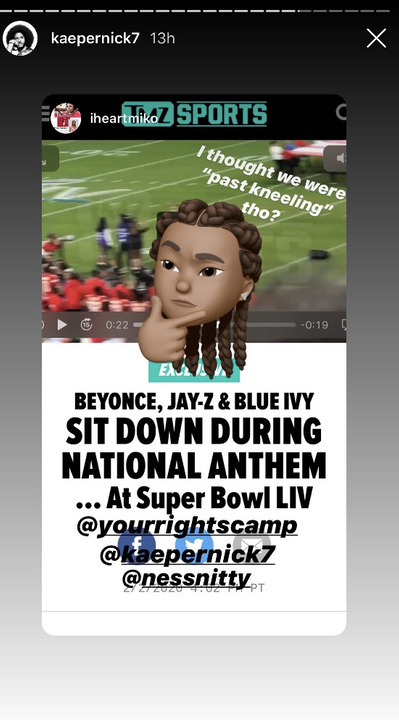
Bigot Barbie Tomi Lahren didn't waste any time verbally attacking The Carters on social media:
Beyoncé & Jay-Z (former crack dealer)sit for the national anthem because apparently the United States of America has oppressed them with millions upon millions of dollars & fans. Sounds rough. Maybe they should try another country that allows them a little more freedom & success?
— Tomi Lahren (@TomiLahren) February 3, 2020
"Beyonce & Jay-Z (former crack dealer) sit for the national anthem because apparently the United States of America has oppressed them with millions upon millions of dollars & fans," she tweeted. "Sounds rough. Maybe they should try another country that allows them a little more freedom & success?"
She's always looking for her little 15 minutes of fame. She knows more than anyone that exercising the right to protest is more American and shows more love for this country than anybody in her party.
Decked out in Ivy Park x Adidas threads, daytime talk show host Wendy Williams said Bey & Jay should have stood during the anthem while delivering her Hot Topics segment today:
@WendyWilliams her always telling it like it is! pic.twitter.com/nvTppyhGv2
— vanessa zayas (@silzayas) February 3, 2020
So, she's dragging Bey while wearing her clothing? Oh. She also threw in that her stylist "received the clothes a few weeks ago," seemingly trying to hint Beyoncé - who is known to not have a relationship with Wendy - gifted the clothes to them. But who even knows.
Outside of the drama, Bey shared flicks from her personal stash of her Super Bowl outfit:
View this post on Instagram
A post shared by Beyoncé (@beyonce) on Feb 2, 2020 at 4:37pm PST
The Lion King star rocked a green Balmain suit accessorized with Messika Paris jewelry.
The Carters brought their daughter Blue Ivy for the Super Bowl festivities:
Jay-Z x @MeekMill at #SBLIV
: #SBLIV | 6:30pm ET on FOX
: NFL app // Yahoo Sports app pic.twitter.com/aUDcoSc6Lw
— NFL (@NFL) February 2, 2020
Blue & JAY-Z at the Hard Rock Staduim #SuperBowl pic.twitter.com/xtNxw2gZJA
— Moe Samir | Pop Culture & Music Expert (@TheMoeSamir) February 2, 2020
pic.twitter.com/g2v5TIhoXX
— Família Carter (@familiacarterbr) February 2, 2020
Beyoncé and Jay Z have just arrived at the Hard Rock Stadium #SuperBowl pic.twitter.com/19AytDhSrl
— Moe Samir | Pop Culture & Music Expert (@TheMoeSamir) February 2, 2020
Beyoncé pic.twitter.com/vCM3u3yOPO
— Família Carter (@familiacarterbr) February 2, 2020
Beyoncé e JAY-Z pic.twitter.com/JR0JhHfY79
— Família Carter (@familiacarterbr) February 3, 2020
So, what are your thoughts about the NFL's anti-police brutality ad? Also, how do you feel about The Carters sitting out the National Anthem?!
Photo: Twitter
[Read More ...]
source http://theybf.com/2020/02/03/nfl-airs-anti-police-brutality-ad-during-the-super-bowl-blackballed-colin-kaepernick-give
0 notes
Text
New story in Politics from Time: How Far-Right Personalities And Conspiracy Theorists Are Cashing In On The Pandemic Online
On the evening of Feb. 6, as U.S. news networks reported the death of a doctor in Wuhan, China, who had warned of a deadly new virus, thousands of Americans were tuning in to a different kind of show.
“The good news is I heard actually that you can’t get this if you’re white,” Nick Fuentes, a far-right political commentator, told viewers on his “America First” channel on the streaming platform DLive. “You’re only really susceptible to this virus if you’re Asian,” Fuentes continued. “I think we’ll be O.K.”
Fuentes, 22, a prolific podcaster who on his shows has compared the Holo-caust to a cookie-baking operation, argued that the segregation of Black Americans “was better for them,” and that the First Amendment was “not written for Muslims,” is doing better than O.K. during the COVID-19 pandemic. He’s part of a loose cohort of far-right provocateurs, white nationalists and right-wing extremists who have built large, engaged audiences on lesser-known platforms like DLive after being banned from main-stream sites for spreading hate speech and conspiracy theories.
The model can be lucrative. Viewers pay to watch the livestreams through subscriptions and donations, and the platform allows the content creators to keep most of the revenue. Fuentes appears to have earned more than $140,000 off his DLive streams, cementing himself as the most viewed account on the platform, according to calculations provided to TIME by a livestreaming analyst who was granted anonymity because of their work tracking these accounts. Fuentes is hardly alone. Eight of the 10 top earners on DLive this year as ranked by Social Blade, a social-media analytics website, are far-right commentators, white-nationalist extremists or conspiracy theorists.
The social disruption and economic dislocation caused by the virus–as well as the nationwide protests and civil un-rest that followed the death of George Floyd in late May–has helped fuel this growing, shadowy “alt tech” industry. As public spaces shut down in March, millions of Americans logged online; the livestreaming sector soared 45% from March to April, according to a study by software sites StreamElements and Arsenal.gg. As people became more socially isolated, many increasingly turned to pundits peddling misinformation, conspiracy theories and hate speech. And even as mainstream platforms cracked down on far-right propagandists, online audiences grew. Over the past five months, more than 50 popular accounts reviewed by TIME on sites like DLive have multiplied their viewership and raked in tens of thousands of dollars in online currency by insisting COVID-19 is fake or exaggerated, encouraging followers to resist lockdown orders and broadcasting racist tropes during the nationwide protests over police brutality. Many of these users, including Fuentes, had been banned by major social-media platforms like YouTube for violating policies prohibiting hate speech. But this so-called deplatforming merely pushed them to migrate to less-regulated portals, where some of them have attracted bigger audiences and gamed algorithms to make even more money. In addition, clips of their broadcasts on less-trafficked sites still frequently make it onto YouTube, Twitter and other mainstream platforms, essentially serving as free advertising for their streams elsewhere, experts say.
As social-media giants like YouTube, Twitter and Facebook target hate speech and misinformation, sites like DLive seem to be turning a blind eye, former users and employees say, recognizing that much of their traffic and revenue comes from these accounts. “They care more about having good numbers than weeding these people out,” a former employee of DLive, who was granted anonymity because he still works in the livestreaming sector, tells TIME. (DLive did not respond to multiple requests for comment.)
Which means ordinary users on gaming and streaming platforms, many of them teenagers, are often one click away from white-nationalist content. Many of these far-right personalities allege they are being unfairly censored for conservative political commentary or provocative humor, not hate speech. Most of these viewers won’t respond to streamers’ often cartoonish calls to action, like the “film your hospital” movement in April meant to show that no patients were there, thus “proving” that COVID-19 was fake. But this murky ecosystem of casual viewers, right-wing trolls–and the occasional diehard acolyte–creates a real challenge for technology companies and law-enforcement agencies.
And it doesn’t take much to trigger a tragedy. Over the past two years, terrorists inspired by online right-wing propa-ganda have livestreamed their own deadly attacks in New Zealand and Germany. In March 2019, a Florida man who had been radicalized by far-right media and online conspiracy theorists pleaded guilty to sending more than a dozen pipe bombs to prominent critics of President Donald Trump. A month later, a gunman armed with an AR-15 shot four people, killing one, in a synagogue in Poway, Calif., after allegedly posting a racist and anti-Semitic screed on the site 8chan. About three months later, a man killed 23 people at a Walmart in El Paso, Texas, after posting a racist manifesto online, according to authorities.
With COVID-19 continuing to surge in parts of the country, ongoing protests over racial injustice and the upcoming 2020 U.S. presidential election, the next few months promise to offer fertile ground for bad actors in unmoderated virtual spaces. Far-right propagandists “are really capitalizing on this conspiratorial moment,” says Brian Friedberg, a senior researcher at the Harvard University Shorenstein Center’s Technology and Social Change Project. “Everyone’s locked inside while there is what they refer to as a ‘race war’ happening outside their windows that they are ‘reporting on,’ so this is prime content for white-nationalist spaces.”
The migration of far-right personalities to DLive illustrates how, despite mainstream platforms’ recent crack-downs, the incentives that govern this ecosystem are thriving. Anyone with an Internet connection can continue to leverage conspiracy theories, racism and misogyny for attention and money, experts say.
The outbreak of COVID-19 arrived during a period of reinvention for far-right propagandists in the aftermath of the white-nationalist “Unite the Right” rally in Charlottesville, Va., in 2017. Over the past three years, social-media giants, which had endured criticism for giving extremists safe harbor, have increasingly attempted to mitigate hate speech on their sites. Facebook, YouTube and Twitter, as well as payment processors like PayPal and GoFundMe, have all shut down accounts run by far-right agitators, neo-Nazis and white supremacists. In late June, YouTube removed the accounts of several well-known figures, including David Duke, a former leader of the Ku Klux Klan, and Richard Spencer, a prominent white nationalist. Reddit, Facebook and Amazon-owned streaming site Twitch also suspended dozens of users and forums for violating hate-speech guidelines.
But these purges hardly solved the problem. Many online extremists were on main-stream platforms like YouTube long enough to build a devoted audience willing to follow them to new corners of the Internet. Some had long prepared for a crackdown by setting up copycat accounts across different platforms, like Twitch, DLive or TikTok. “These people build their brand on You-Tube, and when they get demonetized or feel under threat they’ll set up backup channels on DLive or BitChute,” says Megan Squire, a computer scientist at Elon University who tracks online extremism. “They know it’s going to happen and plan ahead.”
While the suspensions by social-media companies have been effective at limiting the reach of some well-known personalities like conspiracy theorist Alex Jones, who was banned from YouTube, Facebook and Apple in 2018, others have quickly adapted. “Content creators are incredibly adept at gaming the systems so that they can still find and cultivate audiences,” says Becca Lewis, a researcher at Stanford University who studies far-right subcultures online, describing these efforts as a “game of whack-a-mole.” Many white-nationalist accounts have tied their ban to the right-wing narrative that conservatives are being silenced by technology companies. For platforms like DLive, becoming what their users consider “free speech” and “uncensored” alternatives can be lucrative. “More speech also means more money for the platform, and less content moderation means less of an expense,” says Lewis.
The prospect of being pushed off main-stream social-media, video-streaming and payment platforms has also prompted extremists to become more sophisticated about the financial side of the business. While Twitch takes a 50% cut from livestreamers’ earnings and YouTube takes 45%, platforms like DLive allow content creators to keep 90% of what they make. And as many found themselves cut off from mainstream payment services like PayPal, GoFundMe and Patreon, they began to embrace digital currencies.
DLive was founded in December 2017 by Chinese-born and U.S.-educated entrepreneurs Charles Wayn and Cole Chen, who made no secret of their ambition to build a platform that rivaled Twitch. They described the site as a general-interest streaming platform, focused on everything from “e-sports to lifestyle, crypto and news.” But two things set it apart from its competitors: it did not take a cut of the revenue generated by its streamers, and it issued an implicit promise of a less moderated, more permissive space.
DLive’s first big coup came in April 2019 when it announced an exclusive streaming deal with Felix Kjellberg, known as PewDiePie. In just two months, DLive’s total number of users grew by 67%. At the time, Kjellberg was the most popular individual creator on YouTube, with more than 93 million subscribers and his own controversial history. In 2018, he came under fire for making anti-Semitic jokes and racist remarks, and more than 94,000 people signed a Change.org petition to ban his channel from YouTube for being a “platform for white-supremacist content.” The petition noted that “the New Zealand mosque shooter mentioned PewDiePie by name and asked people to subscribe.”
DLive’s community guidelines theoretically prohibit “hate speech that directly attacks a person or group on the basis of race, ethnicity, national origin, religion, disability, disease, age, sexual orientation, gender or gender identity.” But it soon became apparent to both employees and users that executives were willing to ignore venomous content. By early 2019, “political” shows were gaining traction on the site. Those programs devolved into “streams dedicated to white pride and a lot of anti-Semitism, entire streams talking about how Jewish people are evil,” says the former DLive employee who spoke to TIME, adding that moderators acted much more quickly when it came to copyright concerns. “Your stream would be taken down faster for streaming sports than saying you hate Jews.”
The employee recalls raising the matter with Wayn, noting how off-putting it was for new users coming to watch or broadcast streams of popular video games. According to the employee, Wayn explained that the company “didn’t want to get rid of these problematic streamers because they brought in numbers.” The founders knew they had to keep viewers because, as Wayn noted in a 2019 interview, if they wanted to “compete with Twitch on the same level and even take them down one day, DLive needs to match its scale.” Wayn did not respond to multiple requests for comment.
By June 2020, DLive seemed to be openly cultivating a right-of-center audience. On Twitter, it briefly changed its bio to read “All Lives Matter,” a right-wing rallying cry in response to Black Lives Matter. The site has increasingly become a haven for fanaticism, says Joan Donovan, the research director of Harvard’s Shorenstein Center. “Before, on YouTube, some of these people would do a dance with the terms of service,” she tells TIME. “But on DLive, the gloves are off, and it’s just full white-supremacist content with very few caveats.”
On the night of June 29, Fuentes had 56% of the site’s total viewership at 10 p.m., according to the review of the site’s analytics provided to TIME. An additional 39% was viewers of 22 other extremist personalities streaming their commentary. At one point on the night of Aug. 10, just 176 of the more than 15,000 viewers on the top 20 channels on the site were not watching accounts linked to far-right figures. Popular programming in recent months has included alarmist footage of racial-justice protests, antivaccine propaganda, conspiracies linking 5G networks to the spread of COVID-19 and calls to “make more white babies while quarantined.”
The company may be even more reliant on those accounts now. Some users have left the site, complaining publicly about the virulent racism and anti-Semitism spilling over into regular channels and game streams. “DLive is a safe-haven for racists and alt-right streamers,” one user wrote on Twitter on June 22. “Seems to me DLive is the new platform for white supremacists,” wrote another, echoing complaints that it’s a “literal Nazi breeding ground” and “the place where racists don’t get deplatformed.”
The migration of hate speech to far-flung corners of the Internet could make it harder to track, increasing the risk that it spills into the offline world. Experts say law-enforcement and national-security agencies are still unprepared to tackle right-wing extremism. They lack expertise not only in the rapidly evolving technology but also in the ideological ecosystem that has spawned a battery of far-right movements. The recently repackaged white-nationalist youth movement, with new names like “America First” or the “Groypers,” looks more like “gussied-up campus conservatives,” as Friedberg of Harvard’s Shorenstein Center puts it, “so they are not triggering the same warning bells.”
Recent incidents show how this online environment that blends political commentary and hate speech can be dangerous. An 18-year-old accused of firebombing a Delaware Planned Parenthood clinic in January was identified through his Instagram profile, which contained far-right memes reflecting popular beliefs in the young white-nationalist movement, according to BuzzFeed News. In June, Facebook deactivated nearly 200 social-media accounts with ties to white-nationalist groups rallying members to attend Black Lives Matter protests, in some cases armed with weapons.
Analysts who track extremist recruitment online also warn that the pandemic may have long-term effects on young people who are now spending far more time on the Internet. Without the structure of school and social activities, many children and teenagers are spending hours a day in spaces where extremist content lurks alongside games and other benign entertainment, says Dana Coester, an associate professor at West Virginia University who researches the impact of online white extremism on youth in Appalachia. It’s common, she notes, to see teenagers sharing Black Lives Matter messages alongside racist cartoons from popular Instagram accounts targeting middle schoolers. “So many parents I’ve spoken with say their kids are on devices until 3 in the morning,” she says. “I can’t begin to imagine how much damage can be done with kids that many hours a day marinating in really toxic content.”
Analysts warn that both U.S. law enforcement and big technology companies need to move quickly to hire experts who understand this new extremist ecosystem. Experts say the mainstream platforms’ recent purges are reactive: they patch yesterday’s problems instead of preventing future abuses, and focus on high-profile provocateurs instead of the underlying networks.
One solution may be to follow the money, as content creators migrate to new platforms in search of new financial opportunities. “[White supremacists] have become particularly as-siduous at exploiting new methods of fundraising, often seeking out platforms that have not yet realized how extremists can exploit them,” said George Selim, senior vice president of programs of the Anti-Defamation League, in testimony before a House subcommittee in January. “When a new fund-raising method or platform emerges, white supremacists can find a window of opportunity. These windows can, however, be shut if platforms promptly take countermeasures.”
On the evening of Aug. 11, Joe Biden’s pick of Senator Kamala Harris as his running mate dominated the news. “She hates white people,” Fuentes told viewers on DLive. “She is going to use the full weight of the federal government … to destroy conservatives, to destroy America First, anybody that speaks up for white people.” NBC and ABC News–which have a combined 13 million subscribers on YouTube–had an average of 6,100 concurrent viewers watching their coverage. Fuentes’ show had 9,000.
–With reporting by ALEJANDRO DE LA GARZA/NEW YORK
from Blogger https://ift.tt/31eBuSM
via IFTTT
0 notes
Text
Political Parties Are Not as Good as Government Officials at Counting Votes
ProPublica is a Pulitzer Prize-winning investigative newsroom. Sign up for The Big Story newsletter to receive stories like this one in your inbox.
Here’s the takeaway from the Iowa fiasco: Beware of caucuses run by political parties. But don’t panic about the integrity of most primaries and the general election, which are run by state and county election administrators.
As Tuesday morning wore on without results from Iowa’s Democratic caucuses, the long-awaited first test of the strength of President Donald Trump’s would-be challengers, both public officials and enraged commentators stoked fears that Iowa was a harbinger of chaos for the rest of the 2020 campaign. Some said it raises alarms about the broader condition of election security and the reliability of computer systems that record, tally and publish the votes. Trump campaign manager Brad Parscale even suggested on Twitter Monday, without evidence, that the process was “rigged.”
But there’s a marked difference between the Iowa caucuses and the upcoming primaries in New Hampshire and South Carolina, as well as the 14 state primaries on Super Tuesday. The Iowa Democratic Party ran the caucuses, much as its counterparts in Nevada, Wyoming and several territories will do in the next few months. Party officials have less training and experience in administering the vote than do state and local election administrators who oversee most of the primaries.
Reflecting such concerns, the Democratic nominating process includes fewer caucuses this year than it did in 2016. The Democratic National Committee has called for using government-run primaries rather than party-run caucuses.
“Caucuses are run by rank amateurs. Even though we have concerns about the capacity of election officials, at least this is what they do a lot of,” said Charles Stewart, who runs MIT’s election data and science lab. “Even in the smallest of jurisdictions you run a lot of elections — you have contingency plans. The parties, bless their hearts, they don’t do this very much and that’s the bottom line.”
Connecticut Secretary of State Denise Merrill, whose office will oversee the state’s primary in April, said, “The Iowa caucus is an excellent reminder of why important elections should be run by trained, skilled and experienced state and local election administrators, not political parties.” Connecticut’s results undergo a post-election audit, and all votes there are on paper.
“Connecticut’s voters should be confident that they can trust the results of our elections,” she said.
In retrospect, Iowa’s Democratic Party made one mistake after another. It introduced a new app, widely reported to have been made by a company called Shadow Inc., without sufficient testing, training of precinct captains or transparency. At the same time, it made reporting requirements more complex, so that the 1,600 Democratic volunteers who manage individual precincts were required to provide three times as many data points as in past caucuses on a brand new app many had never been trained to use. (There were also many more candidates this year, further multiplying the amount of information to be reported.) Party officials didn’t hire enough people to take reports by phone in case the system failed. And they managed expectations poorly, assuring the public that results would be published faster than ever before.
“These are probably the most prepared we’ve ever been as a party for these caucuses,” Iowa Democratic Party Chair Troy Price told CBS on Monday morning, while shrugging off concerns about the possibility of technical problems. “We’re ready.”
This is not the first time that administrative problems have plagued the Iowa caucuses. In 2012, Mitt Romney was declared the winner of the Republican caucuses shortly after 1:30 a.m. by eight votes over Rick Santorum. Two weeks later, a recount showed Santorum had actually won. And in 2016, Hillary Clinton’s campaign declared victory after 2:30 a.m., even though official counting was not completed until that afternoon.
This year, the brand-new technology, lack of training and overconfidence by the state party amounted to a perfect storm. Government officials said they became aware of problems in the late afternoon, when precinct chairs began to report problems logging into the app. Many gave up on the app and began calling results in — as they’d done in past elections — but the reduced number of staff meant wait times so long that precinct leaders went home before they could report the results.
“Everyone was having the same problem,” said one Des Moines official who declined to be named. “Early on, it was obvious there were going to be problems.”
The receptionist at a WeWork office building in Washington, D.C., where Shadow Inc. listed its office in campaign finance filings, told a ProPublica reporter Tuesday that the company had recently moved out. Shadow CEO Gerard Niemira did not respond to a text message seeking comment Tuesday, and the voicemail box on his cellphone was full. An email to ACRONYM — an affiliated company — went unreturned.
One reason that caucus results are difficult to count is because they have multiple tallies. If a candidate doesn’t get 15% of the vote the first time, his or her supporters can switch to a rival. Delegates are apportioned by a mathematical formula. Now, the party is going through the painstaking process of verifying three datasets: the first expression of preference, the realignment and the overall delegate numbers. Verifying each number from each precinct takes several minutes, and the process must be repeated for more than 1,600 precincts. Because the Democratic Party did take the precaution of backing up counts on paper ballots, the final results should be verifiable. State party and federal officials have expressed confidence that the outcome will be accurate and trustworthy.
In a two-minute call just after 1 a.m. with the media, Price said the party was “validating every piece of data we have within that paper trail” and would “report results with full confidence.”
“We have said all along: We had backups in place for exactly this reason,” he said.
In a statement, Iowa Secretary of State Paul Pate, a Republican, said he was “glad to hear [the Iowa Democratic Party has ] a paper trail for their votes, just as we use paper ballots in all official elections in the state of Iowa.”
“I support IDP while they take their time and conduct checks and balances to ensure the accuracy and integrity of the votes,” he said.
Records show the state’s Democratic Party paid $60,000 to Shadow Inc. in two installments in November and December. The app was introduced with the intent of speeding up reporting. While local and national media began asking about the app weeks ago, the party was largely silent about its mechanics and said little about testing or training. Appearing on “Fox & Friends” Tuesday morning, Acting Department of Homeland Security Secretary Chad Wolf, said that the Iowa Democratic Party had declined to allow DHS to conduct vulnerability testing on the app, though he said DHS saw no signs of malicious activity. The party has put out a statement that it has confirmed there were no intrusions and that the problems were the result of a “coding issue in the reporting system.”
The confusion in Iowa does raise concerns about the rest of 2020’s caucuses, as well as states — such as Hawaii and Alaska — where parties run primaries. The Nevada State Democratic Party, which paid Shadow Inc. $58,000 in August for “technology services,” will hold its caucuses on Feb. 22. The state party did not return a call for comment about the payment or whether it is using Shadow to report returns.
Experts said that using little-tested apps can raise the risk of security breaches because hackers could take advantage of an app’s poor computer coding. Some criticized the secrecy that shrouded the app itself.
“For critical software, I always look for documented, third-party security validation and transparency into the testing process the vendor used,” said Chris Wysopal, the chief technology officer at security firm Veracode and a prominent computer security expert. “It is a big, red flag if there is secrecy about the development process used to create and test an app.”
Election observers said one lesson of Iowa is that accuracy and clarity should be valued over speed. “It’s not about election integrity — the results will be verified with paper — it’s about satisfying our need to know immediately who won,” said David Becker, the executive director of the Center for Election Innovation & Research. “When we balance out what’s more important, speed or accuracy, it’s not even a close call. We should be expecting accuracy and adjusting our expectations in regards to speed.”
0 notes
Text
In The Bunker With Mick The Grip - Christmas 2017 has been published at http://www.theleader.info/2017/12/27/bunker-mick-grip-christmas-2017/
New Post has been published on http://www.theleader.info/2017/12/27/bunker-mick-grip-christmas-2017/
In The Bunker With Mick The Grip - Christmas 2017
RECOMMENDED FOR CHRISTMAS VIEWING: “The Greatest Game Ever Played,” the 2005 film telling the story of amateur golfer Francis Ouimet’s historic US Open win in 1913 at the Country Club in Brookline, Mass. 20 yr.old Ouimet was accompanied by his caddie, 10 yr.old Eddie Lowery, who was playing truant from school. Francis won the 18-hole playoff, beating England’s Harry Vardon by 5 strokes and Ted Ray by 6. His victory was a stunning upset for the strongly favoured British, who were regarded as the world’s top two golfers. The first amateur to win the U.S. Open, Ouimet’s achievement on that soaking wet weekend, in his woollen suit and squelching shoes, made front-page news. Francis Ouimet grew up in a rundown house across the street from the course, and could see from his bedroom window the most important holes he would ever play. Even allowing for Disney’s poetic licence, it’s a great story. Suggest watching it after the evening news, these days enough to make anyone reach for the jolly juice. DURING HIS FIRST trip to Japan, Donald Trump played a round of golf with Japanese Prime Minister Shinzo Abe and Hideki Matsuyama at the Kasumigaseki Country Club, proposed site of the 2020 Olympic golf tournament. A local television station captured Prime Minister Abe’s shot from a fairway bunker. Trump and Matsuyama were walking off as Abe charged up the side of the bunker after them — even getting one foot on the top before losing his balance, tumbling backwards in a half-somersault and landing flat on his back at the bottom of the bunker. It’s not often Donald is upstaged at getting a laugh. JUSTIN ROSE just missed the Race to Dubai, but he did win back-to-back tournaments in China and Turkey. He also received £2,000.000 to put in his Christmas stocking. Beats an orange. The Turkish trophy was presented by the world champion hoverboarder who flew in on a drone. Novel touch, however I can’t see the captain of the R & A flying in on a drone with the Claret Jug. (I wonder if they call it The Turkey Trophy). TOMMY FLEETWOOD, who won the Race to Dubai, is back with his old coach Alan Thompson. He says: “In 2015 I decided I wanted to hit like Henrik Stenson, so I switched coaches and asked Pete Cowen to help me, but I couldn’t get my body to swing the way we wanted, and lost my rhythm. Pete taught me a lot anyway, but I hadn’t realised how difficult and dangerous it would be to try and change my swing.” If it aint broke etc., THE CUSTOM-MADE sunglasses worn by Henrik Stenson were designed by his very own company, named, amazingly: “Henrik Stenson Eyewear.” The company produces everyday glasses as well. If they don’t help you hit a ball like Henrik at least they can help you see where it’s gone. RG GOLF TIP FOR BUNKER SHOTS: If you just open the club face up, you’re not adding more loft, just pointing it further right. To hit this shot you need to drop the butt end all the way down to actually create some loft. Merely opening the club face won’t do it. Take a wider stance with the butt end low and club flat, that will help you to hit a shallower shot which actually gives more elevation. RORY MCILROY intends to begin his PGA TOUR season with the AT&T Pebble Beach Pro-Am on Feb. 8-11, followed by the Genesis Open on Feb. 15-18 and The Honda Classic on Feb. 22-25. Rory, who will be making his Pebble Beach debut, is scheduled to play alongside his father, Gerry. Hope he can remember which end of his club to hold, or Pop may upstage him. WHILE ON HOLIDAY, Frank went into a golf shop, and selected some new clubs. He walked to the checkout, pulling out his wallet. The pretty blonde cashier said: “Strip down, facing me.” Not quite sure what was going on Frank did as she asked. When the hysterical shrieks of laughter finally subsided he asked, “What’s so funny?” “I was telling you how to hold your credit card,” the cashier responded. A very Merry Christmas to all, and Happy Golfing in 2018. Contact Mick for your regripping and repairs. 638 859 475.
0 notes
Photo

New Post has been published on https://vacationsoup.com/favorite-daytona-500-thrills-and-memories/
Favorite Daytona 500 Thrills and Memories

What is your favorite Daytona 500 memory? Even non-race-car-fans have favorite Daytona 500 thrills and memories.

The Thunderbirds flyover as President Donald Trump, accompanied by first lady Melania Trump, stands during the national anthem before the start of the NASCAR Daytona 500 auto race at Daytona International Speedway, Sunday, Feb. 16, 2020, in Daytona Beach, Fla. (AP Photo/Alex Brandon)
Thunderbirds
Just prior to announcing the start of the race, the famous US Air Force Thunderbirds flyover the race track. Tucked 18 inches apart at 500 mph, the six F-16 falcons scream across the sky in their signature Delta formation above the World Center of Racing. Jaws drop in awe. American hearts swell with pride.

Danica Patrick, driver of the #7 GoDaddy Chevrolet, stands on the grid during qualifying for the Monster Energy NASCAR Cup Series Daytona 500 at Daytona International Speedway on February 11, 2018 in Daytona Beach, Florida. (Photo by Sarah Crabill/Getty Images)
DRIVERS START YOUR ENGINES
The anticipation and excitement builds and builds as the 101,000 fans await the famous words. Finally, after the famous words " DRIVERS START YOUR ENGINES", the thunderous roar of the 40 racing machines is visceral - you physically feel it. The crowd goes wild. A moment and a "feeling" not ever forgotten. The world famous words "Gentlemen Start Your Engines" is a trademark phrase owned by Indianapolis Speedway since 1995. The famous phrase at the beginning of Formula One and NASCAR races has been replaced by a more gender neutral phrase "Drivers Start Your Engines" since 2017. Ladies Janet Guthrie in 1977 (Formula One) and Danica Patrick in 2012 (NASCAR) became the first women drivers to compete at the top levels of racing.


Dale Sr and Dale Jr
Everyone knows the story of Dale Earnhardt and his son Dale Jr. Dale, the legendary #3, "The Intimidator", was a famous top driver , winning 69 Winston Cup races over his career until his horrific crash at age 49. . On the last lap of the Daytona 500 in 2001, he collided with two other cars and crashed into the wall of the 4th (final) turn. He died from head injuries. His son, Dale Jr, finished the race in second place, not knowing at the time of his father's fatal injuries. Dale Jr. continued racing to his own successful career, one of the most popular drivers ever. He won his second Daytona 500 ten years later. His fans appreciated his emotional courage in following in his father's footsteps while making his own mark, and dealing with the intrepidation he had to feel each time he raced that same 4th turn over his career. Another of Dale Sr.'s legacies, was the NASCAR organization's serious improvements made for driver safey after his death. The seatbelt and restraint harness systems were improved, and the tracks were upgraded with impact absorption barriers at key crash points. Of note, no driver has died during a NASAR race since that time.
https://youtu.be/Zfo88N2PFdc
Link to Video
1976 Final Two Laps of Daytona 500
Limping across the Finish Line
In 1976, Pearson and Petty crashed battling for the lead coming out of the fourth turn on the last lap of the Daytona 500. When both cars came to a rest, they had still not crossed the start/finish line. Petty’s car wouldn’t start but Pearson dumped the clutch and kept the car in neutral to slowly cross the finish line to capture the only Daytona 500 of his career. The finish was the slowest under green flag conditions in race history.

Crashes
The 2016 race was the only Daytona 500 since 2010 that did not have at least one wreck involving at least seven cars. The 2014 and 2017 races each had two wrecks with at least 10 cars each. There were 8 multi-car wrecks in the last three Daytona 500s — and 18 multi-car wrecks in the last nine Daytona 500s. In the final 10 scheduled laps of last year’s race, a wreck involving 21 cars unfolded, and the race was red-flagged — stopped. The race was restarted, and after one green-flag lap, there was a seven-car wreck, and the race was red-flagged again. Then there was an eight-car wreck. At speeds of 180-200 MPH (pole qualifier speeds) with inches separating the cars on a bumpy track, and drivers jockeying for position and drafting inches from the bumper in front of them - it is no wonder there are massive wrecks. As I write this today, we are waiting and hoping for a good outcome for Ryan Newman who wrecked and was seriously injured in the last lap of the race this year.
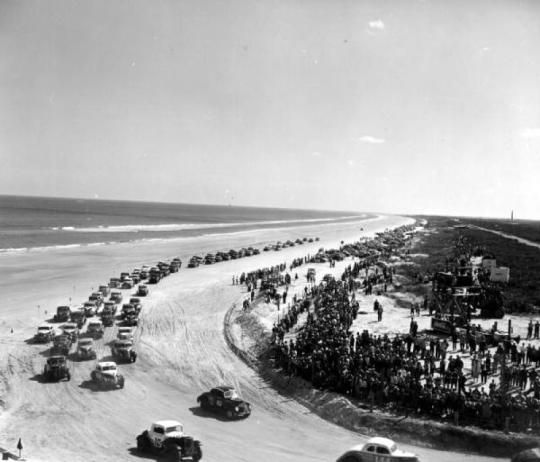
From Sand to Asphalt
Daytona Beach became the unofficial “Birthplace of Speed” in 1903 when two men argued over who had the fastest horseless carriage and decided things in a race on the white, hardpacked sand along the Atlantic Ocean. The speed competitions along the beach by 1958 had graduated to stock cars, which used a 3.2-mile course that combined both the beach and the city of Daytona. Bill France, then a local mechanic, entered the inaugural race on March 8, 1936, and finished fifth. France dabbled in racing for 10 years, became a promoter and founded NASCAR in 1947. By 1953, France recognized that development was going to make it nearly impossible to continue racing a course that utilized the city and the beach so he began plans on a permanent speedway. He signed a $2.5 million agreement a year later for what he decided would be a 2.5-mile tri-oval circuit with 31-degree banking. It was a wildly ambitious plan. “The World Center of Racing” was completed in 1959 and hosted the first Daytona 500 on Feb. 22. A crowd of more than 41,000 watched a field of 59 cars race for a purse of less than $70,000. The finish was so close it took three days to determine Lee Petty had edged Johnny Beauchamp. Here is a link to a fun article about the history of the race.

Riding on the track!
Take a spin on the famous track yourself
You can add to your favorite Daytona 500 thrills and memories by actually riding on the track! Tours of the track are available. When you walk on the track and try to climb up the 31 degree second turn, you will gain a new perspective of the amazing race. If you were in a car racing around the track, you would have to be going faster than 60 MPH to even make it around this turn without falling down to the infield. You can ride with a driver in a real race car or even drive a race car. Depends on how adventurous you are and how much money you are willing to spend. I can say, after having ridden shot gun in a race car at 160 mph up next to the wall, and picturing two other cars crammed close beside me on the 3 wide turn, I am amazed at how they race at all. By the way, this was the best $199 I ever spent. It was really a trill of a lifetime. I am still grinning! Here is the link for the NASCAR RACING EXPERIENCE.
Mark your calendars
Mark your calendars for the next Sunday before President's Day - the traditional date for the Daytona 500 each year. The race has sold out over the last 6 years so don't wait til the last moment! You will likely add to your favorite Daytona 500 thrills and memories!
0 notes
Link
On the evening of Feb. 6, as U.S. news networks reported the death of a doctor in Wuhan, China, who had warned of a deadly new virus, thousands of Americans were tuning in to a different kind of show.
“The good news is I heard actually that you can’t get this if you’re white,” Nick Fuentes, a far-right political commentator, told viewers on his “America First” channel on the streaming platform DLive. “You’re only really susceptible to this virus if you’re Asian,” Fuentes continued. “I think we’ll be O.K.”
Fuentes, 22, a prolific podcaster who on his shows has compared the Holo-caust to a cookie-baking operation, argued that the segregation of Black Americans “was better for them,” and that the First Amendment was “not written for Muslims,” is doing better than O.K. during the COVID-19 pandemic. He’s part of a loose cohort of far-right provocateurs, white nationalists and right-wing extremists who have built large, engaged audiences on lesser-known platforms like DLive after being banned from main-stream sites for spreading hate speech and conspiracy theories.
The model can be lucrative. Viewers pay to watch the livestreams through subscriptions and donations, and the platform allows the content creators to keep most of the revenue. Fuentes appears to have earned more than $140,000 off his DLive streams, cementing himself as the most viewed account on the platform, according to calculations provided to TIME by a livestreaming analyst who was granted anonymity because of their work tracking these accounts. Fuentes is hardly alone. Eight of the 10 top earners on DLive this year as ranked by Social Blade, a social-media analytics website, are far-right commentators, white-nationalist extremists or conspiracy theorists.
The social disruption and economic dislocation caused by the virus–as well as the nationwide protests and civil un-rest that followed the death of George Floyd in late May–has helped fuel this growing, shadowy “alt tech” industry. As public spaces shut down in March, millions of Americans logged online; the livestreaming sector soared 45% from March to April, according to a study by software sites StreamElements and Arsenal.gg. As people became more socially isolated, many increasingly turned to pundits peddling misinformation, conspiracy theories and hate speech. And even as mainstream platforms cracked down on far-right propagandists, online audiences grew. Over the past five months, more than 50 popular accounts reviewed by TIME on sites like DLive have multiplied their viewership and raked in tens of thousands of dollars in online currency by insisting COVID-19 is fake or exaggerated, encouraging followers to resist lockdown orders and broadcasting racist tropes during the nationwide protests over police brutality. Many of these users, including Fuentes, had been banned by major social-media platforms like YouTube for violating policies prohibiting hate speech. But this so-called deplatforming merely pushed them to migrate to less-regulated portals, where some of them have attracted bigger audiences and gamed algorithms to make even more money. In addition, clips of their broadcasts on less-trafficked sites still frequently make it onto YouTube, Twitter and other mainstream platforms, essentially serving as free advertising for their streams elsewhere, experts say.
As social-media giants like YouTube, Twitter and Facebook target hate speech and misinformation, sites like DLive seem to be turning a blind eye, former users and employees say, recognizing that much of their traffic and revenue comes from these accounts. “They care more about having good numbers than weeding these people out,” a former employee of DLive, who was granted anonymity because he still works in the livestreaming sector, tells TIME. (DLive did not respond to multiple requests for comment.)
Which means ordinary users on gaming and streaming platforms, many of them teenagers, are often one click away from white-nationalist content. Many of these far-right personalities allege they are being unfairly censored for conservative political commentary or provocative humor, not hate speech. Most of these viewers won’t respond to streamers’ often cartoonish calls to action, like the “film your hospital” movement in April meant to show that no patients were there, thus “proving” that COVID-19 was fake. But this murky ecosystem of casual viewers, right-wing trolls–and the occasional diehard acolyte–creates a real challenge for technology companies and law-enforcement agencies.
And it doesn’t take much to trigger a tragedy. Over the past two years, terrorists inspired by online right-wing propa-ganda have livestreamed their own deadly attacks in New Zealand and Germany. In March 2019, a Florida man who had been radicalized by far-right media and online conspiracy theorists pleaded guilty to sending more than a dozen pipe bombs to prominent critics of President Donald Trump. A month later, a gunman armed with an AR-15 shot four people, killing one, in a synagogue in Poway, Calif., after allegedly posting a racist and anti-Semitic screed on the site 8chan. About three months later, a man killed 23 people at a Walmart in El Paso, Texas, after posting a racist manifesto online, according to authorities.
With COVID-19 continuing to surge in parts of the country, ongoing protests over racial injustice and the upcoming 2020 U.S. presidential election, the next few months promise to offer fertile ground for bad actors in unmoderated virtual spaces. Far-right propagandists “are really capitalizing on this conspiratorial moment,” says Brian Friedberg, a senior researcher at the Harvard University Shorenstein Center’s Technology and Social Change Project. “Everyone’s locked inside while there is what they refer to as a ‘race war’ happening outside their windows that they are ‘reporting on,’ so this is prime content for white-nationalist spaces.”
The migration of far-right personalities to DLive illustrates how, despite mainstream platforms’ recent crack-downs, the incentives that govern this ecosystem are thriving. Anyone with an Internet connection can continue to leverage conspiracy theories, racism and misogyny for attention and money, experts say.
The outbreak of COVID-19 arrived during a period of reinvention for far-right propagandists in the aftermath of the white-nationalist “Unite the Right” rally in Charlottesville, Va., in 2017. Over the past three years, social-media giants, which had endured criticism for giving extremists safe harbor, have increasingly attempted to mitigate hate speech on their sites. Facebook, YouTube and Twitter, as well as payment processors like PayPal and GoFundMe, have all shut down accounts run by far-right agitators, neo-Nazis and white supremacists. In late June, YouTube removed the accounts of several well-known figures, including David Duke, a former leader of the Ku Klux Klan, and Richard Spencer, a prominent white nationalist. Reddit, Facebook and Amazon-owned streaming site Twitch also suspended dozens of users and forums for violating hate-speech guidelines.
But these purges hardly solved the problem. Many online extremists were on main-stream platforms like YouTube long enough to build a devoted audience willing to follow them to new corners of the Internet. Some had long prepared for a crackdown by setting up copycat accounts across different platforms, like Twitch, DLive or TikTok. “These people build their brand on You-Tube, and when they get demonetized or feel under threat they’ll set up backup channels on DLive or BitChute,” says Megan Squire, a computer scientist at Elon University who tracks online extremism. “They know it’s going to happen and plan ahead.”
While the suspensions by social-media companies have been effective at limiting the reach of some well-known personalities like conspiracy theorist Alex Jones, who was banned from YouTube, Facebook and Apple in 2018, others have quickly adapted. “Content creators are incredibly adept at gaming the systems so that they can still find and cultivate audiences,” says Becca Lewis, a researcher at Stanford University who studies far-right subcultures online, describing these efforts as a “game of whack-a-mole.” Many white-nationalist accounts have tied their ban to the right-wing narrative that conservatives are being silenced by technology companies. For platforms like DLive, becoming what their users consider “free speech” and “uncensored” alternatives can be lucrative. “More speech also means more money for the platform, and less content moderation means less of an expense,” says Lewis.
The prospect of being pushed off main-stream social-media, video-streaming and payment platforms has also prompted extremists to become more sophisticated about the financial side of the business. While Twitch takes a 50% cut from livestreamers’ earnings and YouTube takes 45%, platforms like DLive allow content creators to keep 90% of what they make. And as many found themselves cut off from mainstream payment services like PayPal, GoFundMe and Patreon, they began to embrace digital currencies.
DLive was founded in December 2017 by Chinese-born and U.S.-educated entrepreneurs Charles Wayn and Cole Chen, who made no secret of their ambition to build a platform that rivaled Twitch. They described the site as a general-interest streaming platform, focused on everything from “e-sports to lifestyle, crypto and news.” But two things set it apart from its competitors: it did not take a cut of the revenue generated by its streamers, and it issued an implicit promise of a less moderated, more permissive space.
DLive’s first big coup came in April 2019 when it announced an exclusive streaming deal with Felix Kjellberg, known as PewDiePie. In just two months, DLive’s total number of users grew by 67%. At the time, Kjellberg was the most popular individual creator on YouTube, with more than 93 million subscribers and his own controversial history. In 2018, he came under fire for making anti-Semitic jokes and racist remarks, and more than 94,000 people signed a Change.org petition to ban his channel from YouTube for being a “platform for white-supremacist content.” The petition noted that “the New Zealand mosque shooter mentioned PewDiePie by name and asked people to subscribe.”
DLive’s community guidelines theoretically prohibit “hate speech that directly attacks a person or group on the basis of race, ethnicity, national origin, religion, disability, disease, age, sexual orientation, gender or gender identity.” But it soon became apparent to both employees and users that executives were willing to ignore venomous content. By early 2019, “political” shows were gaining traction on the site. Those programs devolved into “streams dedicated to white pride and a lot of anti-Semitism, entire streams talking about how Jewish people are evil,” says the former DLive employee who spoke to TIME, adding that moderators acted much more quickly when it came to copyright concerns. “Your stream would be taken down faster for streaming sports than saying you hate Jews.”
The employee recalls raising the matter with Wayn, noting how off-putting it was for new users coming to watch or broadcast streams of popular video games. According to the employee, Wayn explained that the company “didn’t want to get rid of these problematic streamers because they brought in numbers.” The founders knew they had to keep viewers because, as Wayn noted in a 2019 interview, if they wanted to “compete with Twitch on the same level and even take them down one day, DLive needs to match its scale.” Wayn did not respond to multiple requests for comment.
By June 2020, DLive seemed to be openly cultivating a right-of-center audience. On Twitter, it briefly changed its bio to read “All Lives Matter,” a right-wing rallying cry in response to Black Lives Matter. The site has increasingly become a haven for fanaticism, says Joan Donovan, the research director of Harvard’s Shorenstein Center. “Before, on YouTube, some of these people would do a dance with the terms of service,” she tells TIME. “But on DLive, the gloves are off, and it’s just full white-supremacist content with very few caveats.”
On the night of June 29, Fuentes had 56% of the site’s total viewership at 10 p.m., according to the review of the site’s analytics provided to TIME. An additional 39% was viewers of 22 other extremist personalities streaming their commentary. At one point on the night of Aug. 10, just 176 of the more than 15,000 viewers on the top 20 channels on the site were not watching accounts linked to far-right figures. Popular programming in recent months has included alarmist footage of racial-justice protests, antivaccine propaganda, conspiracies linking 5G networks to the spread of COVID-19 and calls to “make more white babies while quarantined.”
The company may be even more reliant on those accounts now. Some users have left the site, complaining publicly about the virulent racism and anti-Semitism spilling over into regular channels and game streams. “DLive is a safe-haven for racists and alt-right streamers,” one user wrote on Twitter on June 22. “Seems to me DLive is the new platform for white supremacists,” wrote another, echoing complaints that it’s a “literal Nazi breeding ground” and “the place where racists don’t get deplatformed.”
The migration of hate speech to far-flung corners of the Internet could make it harder to track, increasing the risk that it spills into the offline world. Experts say law-enforcement and national-security agencies are still unprepared to tackle right-wing extremism. They lack expertise not only in the rapidly evolving technology but also in the ideological ecosystem that has spawned a battery of far-right movements. The recently repackaged white-nationalist youth movement, with new names like “America First” or the “Groypers,” looks more like “gussied-up campus conservatives,” as Friedberg of Harvard’s Shorenstein Center puts it, “so they are not triggering the same warning bells.”
Recent incidents show how this online environment that blends political commentary and hate speech can be dangerous. An 18-year-old accused of firebombing a Delaware Planned Parenthood clinic in January was identified through his Instagram profile, which contained far-right memes reflecting popular beliefs in the young white-nationalist movement, according to BuzzFeed News. In June, Facebook deactivated nearly 200 social-media accounts with ties to white-nationalist groups rallying members to attend Black Lives Matter protests, in some cases armed with weapons.
Analysts who track extremist recruitment online also warn that the pandemic may have long-term effects on young people who are now spending far more time on the Internet. Without the structure of school and social activities, many children and teenagers are spending hours a day in spaces where extremist content lurks alongside games and other benign entertainment, says Dana Coester, an associate professor at West Virginia University who researches the impact of online white extremism on youth in Appalachia. It’s common, she notes, to see teenagers sharing Black Lives Matter messages alongside racist cartoons from popular Instagram accounts targeting middle schoolers. “So many parents I’ve spoken with say their kids are on devices until 3 in the morning,” she says. “I can’t begin to imagine how much damage can be done with kids that many hours a day marinating in really toxic content.”
Analysts warn that both U.S. law enforcement and big technology companies need to move quickly to hire experts who understand this new extremist ecosystem. Experts say the mainstream platforms’ recent purges are reactive: they patch yesterday’s problems instead of preventing future abuses, and focus on high-profile provocateurs instead of the underlying networks.
One solution may be to follow the money, as content creators migrate to new platforms in search of new financial opportunities. “[White supremacists] have become particularly as-siduous at exploiting new methods of fundraising, often seeking out platforms that have not yet realized how extremists can exploit them,” said George Selim, senior vice president of programs of the Anti-Defamation League, in testimony before a House subcommittee in January. “When a new fund-raising method or platform emerges, white supremacists can find a window of opportunity. These windows can, however, be shut if platforms promptly take countermeasures.”
On the evening of Aug. 11, Joe Biden’s pick of Senator Kamala Harris as his running mate dominated the news. “She hates white people,” Fuentes told viewers on DLive. “She is going to use the full weight of the federal government … to destroy conservatives, to destroy America First, anybody that speaks up for white people.” NBC and ABC News–which have a combined 13 million subscribers on YouTube–had an average of 6,100 concurrent viewers watching their coverage. Fuentes’ show had 9,000.
–With reporting by ALEJANDRO DE LA GARZA/NEW YORK
0 notes
Text
The King Lear Era of Donald Trump’s Presidency
Unconstrained by the law, enabled by his staff, the unitary executive is raging.
By DAHLIA LITHWICK | Published FEB 21, 2020 2:30 PM ET | Slate |
On Thursday, President Donald Trump railed at the Oscars for awarding its highest honors to a foreign film. He then installed an acclaimed insult comic with no national intelligence experience as his acting director of national intelligence, because he prefers hearing from intelligence directors who tell him what he wants to believe as opposed to what is happening. He also indicated that when he threatens judges and jurors involved in federal criminal cases it’s OK because he has First Amendment needs that transcend the demands of rule of law. In other words, in the span of a few days, we’ve moved from unitary executive to peak Lear-wandering-on-the-heath executive. The only remaining operative question is: Who will be rewarded for loving the king as much as the king demands?
The American constitutional order is comprised of two camps in this moment: the president’s enemies and the president’s staffers. Having asserted this week that he is the “chief law enforcement officer of the United States,” and having previously concluded that the Constitution gives him “the right to do whatever I want,” the president has carved the world into the only two categories he comprehends: his interchangeable fixers and his mortal enemies. Attorney General Bill Barr, who auditioned for his position by offering himself up specifically as a fixer, has tried as valiantly as possible to get the president to stop tweeting about ongoing criminal matters. He even said he might quit if the president didn’t stop treating him like the president’s pool boy. Needless to say, he didn’t quit, and is, as a formal matter now, the president’s pool boy.
Even when they depart, nobody ever stops being on the president’s roster of lifelong staffers. Not Don McGahn, not John Bolton, not John Kelly, and not Hope Hicks. Some of them leave the White House and then some drift back to the White House, emptying ashtrays and hampering attempts at obstruction, but they’re forever on staff, lashed to the president by way of elaborate (unenforceable) NDAs, or legal claims of absolute privilege, or by their own paradoxical beliefs that they are not in fact essential to the plot, but also that you should definitely preorder their book about the experience on Amazon.
Staffers are frequently upbraided when they are not appropriately servile. Jeff Sessions is not sufficiently loyal and so is replaced by a Bill Barr. Former acting Director of National Intelligence Joseph Maguire, who helped cover up the Ukraine scandal, is not sufficiently loyal and is to be replaced by an internet troll who will be a part-time ambassador to Germany. Because offering truthful information about Russian threats to the 2020 election indicates disloyalty, the only staffers who can remain on the payroll are those who remember to tell the emperor that his waistcoat is superb. This is pretty standard King George III territory, all bowing and scraping and insisting that the sovereign simply cannot be made to understand that there are rules and procedures, until the rules and procedures stop mattering at all.
Judge Amy Berman Jackson deserves immense credit for taking 45 minutes in her sentencing of Roger Stone on Thursday to remind the president that she actually isn’t on his staff. In her insistence that words have consequences and truth still matters and undermining institutions threatens to topple liberal democracy itself, she was uncompromising about the need for law, neutral arbiters, congressional oversight, and proportionality. The president didn’t understand any of this. Instead, he reminded her that he has limitless pardon power that he will deploy when the time is right. Time and again, we are given to understand that Donald Trump simply does not grasp the fact that the Department of Justice isn’t his personal law firm. It seems everyone’s just given up on attempting to change his mind. We are all in agreement: He’s the only arbiter of his constraints. Spoiler: He doesn’t believe in constraints.
It is ironic, one supposes, that the man who believes himself to be unconditionally empowered has somehow allowed himself to be a purely transactional bit player in a larger Russian scheme to foment mistrust of U.S. election systems. It would demand a smaller ego for Donald Trump to recognize that he was already a pawn in 2016 and is still a useful pawn in 2020. But, having surrounded himself with those who see their role as limiting the flow of unhappy news to him, the fact that he cannot understand how little he understands has become the central feature of his presidency. As the New York Times’ push alert for its news story on Russian interference put it yesterday, “Russia is aiding President Trump in the 2020 election, intelligence officials told lawmakers. Mr. Trump complained Democrats might exploit the news.” That extraordinary pairing of sentences now feels rather normal. The constitutional universe is finally shrunk down to the size of one man’s ability to understand the constitutional universe.
Donald Trump is very dissatisfied with Brad Pitt, bad cops, his intelligence agencies, congressional intelligence briefings, a Roger Stone juror, and the fact that they just don’t make films like Gone With the Wind anymore. Because this is the scope of his constitutional aperture, the world is formally split into friends and enemies, loyalists and spies, the underlings and the other, fired underlings. In this one sense only, Donald Trump was wrong about the limitless reach of his own Article II powers: Yes, they are seemingly infinite, but the rest of us occupy a world that is ever more tragically constrained by the failures of his imagination.
*********
The First Days of the Trump Regime
The president has interpreted the Republican-controlled Senate’s vote to acquit as a writ of absolute power.
By Adam Serwer | Published February 19, 2020 | The Atlantic | Posted February 22, 2020 |
There are two kinds of Republican senators who voted to acquit Donald Trump in his impeachment trial two weeks ago: those who acknowledged he was guilty and voted to acquit anyway, and those who pretended the president had done nothing wrong.
“It was wrong for President Trump to mention former Vice President Biden on that phone call, and it was wrong for him to ask a foreign country to investigate a political rival,” Senator Susan Collins of Maine declared, but added that removing him “could have unpredictable and potentially adverse consequences for public confidence in our electoral process.”
But Collins, like her Republican colleagues Lisa Murkowski of Alaska and Lamar Alexander of Tennessee, was an outlier in admitting the president’s conduct was wrong. Most others in the caucus, like Senator Tom Cotton of Arkansas, deliberately missed the point, insisting that Democrats wanted the president removed for “pausing aid to Ukraine for a few weeks.”
Peter Wehner: The downfall of the Republican Party
What all these senators share is a willingness to ignore the nature of the offense. Both Collins, who has worked in government in some capacity since the 1970s, and Cotton, a Harvard-educated attorney, understood the basic constitutional arguments for removing a president who attempts to rig a reelection campaign in his favor, which is why they simply ignored them. Collins insisted that the matter be decided by the forthcoming election, disregarding the fact that Trump was impeached because he tried to use his official powers to manipulate that election, while Cotton simply pretended to be clueless about what was at issue.
The ambiguity of these two positions obscures the clarity with which the president and his attorney general, William Barr, have interpreted the acquittal vote. The Senate’s vote to acquit Trump of the impeachment charges he faced, despite the incontrovertible proof that he sought to use his official powers to force a foreign country to falsely implicate a political rival, was not simply a vote to keep him in office until the electorate can render its verdict. Republican senators affirmatively voted to allow the president to use his official powers to suppress the opposition party, to purge government employees who proved more loyal to the Constitution than to Trump, and to potentially prosecute or otherwise criminally implicate his political enemies without lawful cause, while shielding Trump allies from legal sanction. The acquittal vote ratified the authoritarian instincts of the president and the ideological convictions of his attorney general.
The most generous interpretation of the votes of Collins, Murkowski, and Alexander is that the senators believed they were staving off a greater crisis of democracy. But in the eyes of the president, their votes for acquittal were cast to install him as a strongman.
Authoritarian nations come in many different stripes, but they all share a fundamental characteristic: The people who live in them are not allowed to freely choose their own leaders. This is why Republican Senator Mitt Romney of Utah, in his speech announcing his vote to convict on the first article of impeachment, said that “corrupting an election to keep oneself in office is perhaps the most abusive and destructive violation of one’s oath of office that I can imagine.”
Democracies are sustained through the formal process by which power is contested and exchanged. Once that process is corrupted, you have merely the trappings of democracy within an authoritarian regime. Such governments may retain elections and courts and legislatures, but those institutions have no power to enforce the rule of law. America is not there yet—but the acquittal vote was a fateful step in that direction.
The process by which a democracy becomes an authoritarian regime is what social scientists call authoritarianization. The process does not need to be sudden and dramatic. Often, democratic mechanisms are eroded over a period of months or years, slowly degrading the ability of the public to choose its leaders or hold them to account.
Legislators in functioning democracies need not agree on substantive policy matters—they might fight over environmental safeguards, for example, or tax rates, or immigration, or health care. But no matter the party or ideology they support, they must hold sacred the right of the people to choose their own leaders. The entire Senate Republican Conference has only one legislator willing to act on that principle. The lesson Trump has learned from impeachment is that the Republican Party will let him get away with anything he wants to do.
After calling the accusation that Trump collaborated with foreign powers in an effort to swing American elections a "hoax," Barr set up an official channel for the president’s personal attorney, Rudy Giuliani, to funnel foreign dirt on Trump’s rivals to the Justice Department. After falsely claiming that Joe Biden had demanded the ouster of a Ukrainian prosecutor to protect his son, Trump has engaged in the exact act he accused Biden of engaging in, by attempting to shield his henchman Roger Stone from legal consequences for breaking the law on his behalf, leading to the resignation of the prosecutors working on the case. Barr also has handpicked advisers “reviewing” the case against Michael Flynn, the former Trump national security adviser who pleaded guilty to lying to the FBI about his contacts with Russia officials during the transition. The day of Trump’s acquittal, the Justice Department announced that Barr would have to approve any investigations into the 2020 presidential candidates, giving him the authority to shut down criminal investigations of the president’s associates or approve inquiries into his rivals. Speaking to reporters, Trump claimed the “absolute right” to determine who is and who is not prosecuted by the Justice Department. There is no law but Trump.
Modern authoritarian institutions diligently seek to preserve the appearance of democratic accountability. Perhaps for this reason, Barr has insisted publicly that he is protecting the independence of the Justice Department. “I’m not going to be bullied or influenced by anybody,” he told reporters last week. Barr insisted, “If Trump were to say ‘Go investigate somebody,’ and you sense it’s because they’re a political opponent, then an attorney general shouldn’t carry that out, wouldn’t carry that out.” This is a lawyerly dodge masquerading as bluster—Barr does not need to be bullied into shielding Trump and his friends or pursuing his enemies. Indeed, Barr’s task is to do so while maintaining a veneer of legitimacy over the process, which is impossible to do when Trump makes such demands publicly. Privately, Trump seethes that Barr has not thrown more of his critics in prison, as Barr and his underlings scheme to sate the president’s rage.
Although in nearly every other context, Barr has been an advocate for the harshest possible punishments, it would be wrong to say his insistence on leniency for Stone is inconsistent or out of character. He has attacked the reform-minded district attorneys who are pursuing less harsh punishments as “anti-law-enforcement DAs” who are seeking “pathetically lenient” sentences. And he has warned critics of police misconduct that if they don’t “respect” law enforcement, “they might find themselves without the police protection they need”—turning policing from a public service into a protection racket. But Barr is also the man who pushed for pardons for high-ranking government officials who broke federal law in the Iran-Contra affair. The underlying principle here, from Stone to Iran-Contra, is authoritarian but consistent: Members of the ruling clique are entitled to criticize law enforcement without sanction, and entitled to leniency when they commit crimes on the boss’s behalf. Everyone else is entitled to kneel.
Trump has also engaged in a purge of officials who testified truthfully—some of them only somewhat truthfully—in the impeachment hearings. Trump fired his ambassador to the European Union, Gordon Sondland, who confirmed that Trump had conditioned aid to Ukraine on procuring an announcement that Biden’s son Hunter was under investigation by Ukrainian authorities. He removed not only Lieutenant Colonel Alexander Vindman but also his twin brother, Yevgeny Vindman, from the White House staff after Vindman’s truthful testimony that the president sought to coerce Ukraine into falsely implicating the Bidens. Trump mocked Alexander Vindman on Twitter after his ouster by putting his rank in scare quotes, a marked contrast to his effusive praise for war criminals. Similarly, the former U.S. attorney for the District of Columbia, Jessie Liu, had her nomination for a top position in the Treasury Department withdrawn after Trump publicly attacked prosecutors in her office for their handling of the Stone case.
In any administration, political appointees serve at the pleasure of the president. But these officials did not somehow fail in performing their official duties or even clash with official policy. As Republican Senator Jim Inhofe of Oklahoma put it, “People were supposed to have loyalty. Obviously they didn’t.”
Public officials swear an oath to the Constitution, not to Donald Trump. The purged officials were removed for their disloyalty to the latter, not the former. With the exception of Romney, who voted against acquittal on the first of the two charges, the GOP now makes no distinction between fealty to Trump and loyalty to the country. The Founders devised the impeachment clause as a remedy for a chief executive who abuses his power to stay in office. But as there were no parties at the time of the founding, they did not foresee that such a chief executive would be shielded by toadies who envision their civic obligations as beginning and ending with devotion to the leader.
Much has been made of Trump’s unfitness for office. But if Trump were the only one who were unfit, his authoritarian impulses would have been easier to contain. Instead, the Republican Party is slowly transforming into a regime party, one whose primary duty is to maintain its control of the government at all costs. The benefits here are mutual: By keeping Trump in power, the party retains power. Individuals who want to rise in the Republican Party and its associated organizations today must be unwavering in their devotion to the leader—that is the only way to have a career in the GOP, let alone reap the associated political and financial benefits. Allowing Trump to fall would render all the humiliations, compromises, and sacrifices the party has made to keep him in power meaningless.
But keeping Trump in office is not the ultimate goal, despite party members’ obsequious public performances toward Trump. Rather, the purpose is to preserve the authoritarian structure Trump and Barr are building, so that it can be inherited by the next Republican president. To be more specific, the Trump administration is not fighting a “deep state”; it is seeking to build one that will outlast him.
These recent events are not the only evidence that the United States has entered a process of authoritarianization. Aside from Trump’s claim, effectively uncontested by Senate Republicans, that he can unilaterally direct the Justice Department to prosecute anyone he wants, Trump has asserted blanket authority to block congressional oversight. His office has claimed that he can blithely ignore congressional appropriations as he sees fit. The Republican-controlled Senate has ratified Trump’s authority to interfere in American elections, while helping install judges who understand that their paramount obligation is to shield Trump from accountability. The president’s public attacks on political opponents and detractors, and his demands that they be sanctioned or prosecuted, have had the intended effect of silencing elite criticism of the administration—most former high-ranking military officials would only anonymously rebuke the president’s purge of the Vindmans and his subsequent attacks on them. Potential future dissidents are meant to note the folly of placing their civic obligations before the whims of the president.
Let us pause for a moment to take stock of this vision of government. It is a state in which the legislature can neither oversee the executive branch nor pass laws that constrain it. A state in which legal requests for government records on those associated with the political opposition are satisfied immediately, and such requests related to the sitting executive are denied wholesale. It is a system in which the executive can be neither investigated for criminal activity nor removed by the legislature for breaking the law. It is a government in which only the regime party may make enforceable demands, and where the opposition party may compete in elections, but only against the efforts of federal law enforcement to marginalize them for their opposition to the president. It is a vision of government in which members of the civil service may break the law on the leader’s behalf, but commit an unforgivable crime should they reveal such malfeasance to the public.
Were it in any other nation, how would you describe a government that functions this way?
Trump’s record of success in the courts is one reason the U.S. has yet to cross another dangerous threshold—as long as the judiciary remains sympathetic to Trump, he has little motivation to openly defy a court order. But if the day comes when he chooses to do so, we can be certain that Republican legislators will do exactly what they have done every other time Trump has broken the law: nothing.
People may think of authoritarian nations in Cold War terms, as states with bombastic leaders who grant themselves extravagant titles and weigh their chests down with meaningless medals. These are nations without legislatures, without courts, with populations cowed by armies of secret police.
This is not how many authoritarian nations work today. Most have elections, legislatures, courts; they possess all the trappings of democracy. In fact, most deny that they are authoritarian at all. “Few contemporary dictatorships admit that they are just that,” writes the scholar Milan Svolik in The Politics of Authoritarian Rule. “If we were to trust dictators’ declarations about their regimes, most of them would be democracies.”
But the democratic institutions that authoritarian nations retain are largely vestigial or have little power to check the executive, either because they are under regime control, or because they are cowed or co-opted into submission.
Similarly, the typical image of an authoritarian nation involves violently suppressing dissent and assassinating or imprisoning political opponents and journalists. But violent suppression has tremendous risks and costs, and so authoritarians have developed more subtle methods of repression.
“Rather than using brute force to maintain control, today’s authoritarian regimes use strategies that are subtler and more ambiguous in nature to silence, deter, and demobilize opponents,” the scholar Erica Frantz writes. “Doing so serves a number of purposes. It attracts less attention, enables them to plausibly deny a role in what occurred, makes it difficult for opponents to launch a decisive response, and helps the regime feign compliance with democratic norms of behavior.”
Sarada Peri: Trump is going to cheat
The collapse of Joe Biden’s campaign is a case in point. If not for an anonymous whistle-blower, Americans might never have learned of Trump’s effort to use public funds to extort Ukraine into falsely implicating Biden in a crime. But the months-long discussion of baseless allegations of corruption against Biden likely served the same purpose, spooking Democratic primary voters who might have otherwise considered supporting him.
Ultimately, no one can ever know whether Biden’s campaign collapsed because he is a poor candidate, because his policies were unpopular, because he was out-campaigned by his rivals, or because the president successfully used his official powers to destroy a political enemy. One could hardly imagine a more successful example of what Frantz calls “low intensity” political repression—a threat was neutralized with minimal consequences to the Trump administration, indeed without even a clear burden of responsibility for the outcome. If the president’s frame-up of Biden was not a perfect crime, it was close.
The frequent worries that it can happen here are arrogant in one respect: It already has happened here. American democracy has always been most vulnerable to an ideology that reserves democratic rights to one specific demographic group, raising that faction as the only one that possesses a fundamentally heritable claim to self-government. Those who are not members of this faction are rendered, by definition, an existential threat.
In the aftermath of the Compromise of 1877, the Republican Party abandoned black voters in the South to authoritarian rule for nearly a century. But the Southern Democrats who destroyed the Reconstruction governments and imposed one-party despotism imagined themselves to be not effacing democracy, but rescuing it from the tyranny of the unworthy and ignorant. “Genuine democracy,” declared the terrorist turned South Carolina governor and senator Ben Tillman, was “the rule of the people—of all the white people, rich and poor alike.”
Similarly, many members of the Republican elite have transitioned seamlessly from attempting to restrain Trump’s authoritarian impulses to enabling them, all the while telling themselves they are acting in the best interests of democracy. This delusion is necessary, a version of the apocalyptic fantasy that conservative pundits have fed their audiences. In this self-justifying myth, only Trump stands between conservative Americans and a left-wing armageddon in which effete white liberals and the black and brown masses they control shut the right out of power forever.
As the president’s adviser and Fox News host Tucker Carlson has said, Democrats “want to replace you, the American voters, with newly amnestied citizens and an ever-increasing number of chain migrants.” Barr envisions his defense of the regime as a rational response to a “holy war,” waged by “so-called progressives” whose “mission is to use the coercive power of the State to remake man and society in their own image, according to an abstract ideal of perfection.” Michael Anton, the former Trump national-security aide, wrote prior to the 2016 election that “the Left, the Democrats, and the bipartisan junta (categories distinct but very much overlapping) think they are on the cusp of a permanent victory that will forever obviate the need to pretend to respect democratic and constitutional niceties. Because they are.”
Adam Serwer: The dangerous ideas of Bill Barr
To save “democracy” then, they must, at any cost, preserve a system in which only those who are worthy—that is, those who vote Republican—may select leaders and make policy. If that means disenfranchising nonwhite voters, so be it. If it means imposing a nationwide racial gerrymander to enhance the power of white voters at the expense of everyone else, then that is what must be done. And if it means allowing the president to use his authority to prevent the opposition from competing in free and fair elections, then that is but a small price to pay. The irony is no less visible to today’s Trumpists than it was to Tillman, and it is no more an impediment.
The insistence, by Cotton and other Trump defenders, that “the Democrats have never accepted that Donald Trump won the 2016 election, and they will never forgive him, either” has it exactly backwards. Democrats impeached Trump to preserve a democratic system in which they have a chance of winning, in which the president cannot blithely frame his rivals for invented crimes. Republicans acquitted him because they fear that a system not rigged in their favor is one in which they will never win again.
On Thursday, February 6, millions of Americans went about their lives as they would have any other day. They came home from overnight shifts, took the bus to work, made lunch for their children, cursed the traffic on their commute, or went out for a drink with friends. Yet the nation they live in may have been fundamentally changed the day before.
Democratic backsliding can be arrested. But that is an arduous task, and a Trump defeat in November is a necessary but not sufficient step. Many Americans have doubtless failed to recognize what has occurred, or how quickly the nation is hurtling toward a state of unfreedom that may prove impossible to reverse. How long the Trump administration lasts should be up to the American people to decide. But this president would never risk allowing them to freely make such a choice. The Republican Party has shown that nothing would cause it to restrain the president, and so he has no reason to restrain himself.
Since the terrorist attacks of 9/11, the American imagination of catastrophe has been limited to sudden, shocking events, the kind that shatter a sunny day in a storm of blood. That has left Americans unprepared for a different kind of catastrophe, the kind that spreads slowly and does not abruptly announce itself. For that reason, for most Americans, that Thursday morning felt like any other. But it was not—the Senate acquittal marked the beginning of a fundamental transition of the United States from a democracy, however flawed, toward authoritarianization. It was, in short, the end of the Trump administration, and the first day of the would-be Trump Regime.
*********
#u.s. news#trump administration#politics#president donald trump#politics and government#trump scandals#trumpism#republican politics#donald trump#us politics#republican party#republican congress#republicans#2020 presidential election#2020 candidates#2020 election#trump crime syndicate#trump crime family#trump corruption#trump cult
0 notes
Link
November 20, 2019 at 08:05PM
Pete Buttigieg enters the fifth major Democratic debate Wednesday with a newfound status—the candidate in the hot seat.
The South Bend, Ind., mayor will face off against nine other Democratic presidential candidates in Atlanta, but something has changed since last month’s debate: Buttigieg has surged in the polls in Iowa and New Hampshire.
His Democratic competitors are likely to use Wednesday’s debate to try to bring him back down a few pegs. Massachusetts Sen. Elizabeth Warren fielded repeated attacks in the October debate after she jumped in the polls. Now, it’s likely Buttigieg’s turn.
MSNBC and the Washington Post are the co-hosts for Wednesday’s debate, which airs live from 9 p.m. to 11 p.m. EST. The debate will broadcast on MSNBC and stream on MSNBC.com and washingtonpost.com. Viewers can also watch on the NBC News and Washington Post apps, or listen on SiriusXM Channel 118 and TuneIn.
Ten candidates will take the stage, two fewer than last month. The requirements to appear in November’s debate increased since October: candidates had until 11:59 p.m. on Nov. 13 to reach 3% in at least four qualifying polls or 5% in two early state polls since Sept. 12, and needed to receive 165,000 unique donors with at least 600 from at least 20 states.
Here’s everyone who made the cut:
former Vice President Joe Biden
New Jersey Sen. Cory Booker
South Bend, Ind., Mayor Pete Buttigieg
Hawaii Rep. Tulsi Gabbard
California Sen. Kamala Harris
Minnesota Sen. Amy Klobuchar
Vermont Sen. Bernie Sanders
billionaire executive Tom Steyer
Massachusetts Sen. Elizabeth Warren
entrepreneur Andrew Yang
Former United States Secretary of Housing and Urban Development Julián Castro missed the polling requirements and former Texas Rep. Beto O’Rourke dropped out of the race on Nov. 1.
An all-female panel will moderate the debate: the host of MSNBC’s The Rachel Maddow Show Rachel Maddow, NBC’s chief foreign affairs correspondent Andrea Mitchell, NBC News White House correspondent Kristen Welker and Washington Post White House reporter Ashley Parker.
On top of Buttigieg’s recent spike in the polls, other factors have changed since October. Former Massachusetts Gov. Deval Patrick entered the race and former New York City Mayor Michael Bloomberg has also hinted at a run; some argue their candidacies represent a centrist response to Warren’s progressive surge. The House of Representatives also began public hearings for the impeachment inquiry into President Donald Trump—which dominated news on Tuesday and Wednesday. Warren also released—and faced scrutiny for—her plan to pay for Medicare for All. All of these factors will loom over the debate and likely impact questions.
In addition to the news, the usual Democratic issues of healthcare, immigration, taxes and gun control will also likely get more airtime.
This could also be some candidates’ last chance to make a splash before they have to qualify for the sixth Democratic debate in December. Next month’s requirements to make the stage are even harder: candidates will need to get at least 200,000 unique donors with a minimum of 800 from at least 20 states. They’ll also need to receive at least 4% in at least four national or early state polls or 6% in two single-state early state polls. So far, six candidates have qualified.
Follow along for live coverage of tonight’s November Democratic debate.
How is Pete Buttigieg doing in the polls?
Buttigieg has dramatically risen in polls in Iowa and New Hampshire, beating out Warren, Sanders and even Biden. In the latest Des Moines Register/CNN/Mediacom Iowa Poll, 25% of likely 2020 Democratic caucus-goers said Buttigieg would be their first choice for president, dramatically ahead of Warren’s 16%, Biden’s 15% and Sanders’s 15%. The poll has a margin of error of 4.4 percentage points. Warren had led the poll in September, with 22% saying she was their first choice.
According to RealClearPolitics’ average of Iowa Democratic Presidential Caucus polls on Wednesday, Buttigieg leads the pack with 22.7%, followed by Biden’s 18.7%, Warren’s 17.3% and Sanders’ 16.7%.
Buttigieg also has a 10-point lead in New Hampshire in a Saint Anselm College poll released on Tuesday, which found that he had 25% support among self-identified likely Democratic primary voters, with a margin of error of 6.1 points. That’s a 15-point jump from the last Saint Anselm College poll in September. Despite his lead in the new poll, he’s still not the consensus pick for the Granite State. Warren leads RealClearPolitics’ average of New Hampshire Democratic Presidential Primary polls on Wednesday with 20.7%, followed by Biden’s 19.0% and Buttigieg in third at 18.7%.
Iowa and New Hampshire are crucial because they are the earliest to weigh in on the Democratic primary process. The Iowa Caucus on Feb. 3 is the first major contest of the election year, followed on Feb. 11 by the first primary election in New Hampshire. Nevada comes third on Feb. 22 and South Carolina fourth on Feb. 29.
Buttigieg hasn’t made as much progress in Nevada or South Carolina. Biden leads in RealClearPolitics’ polling average of the Nevada Democratic Presidential Caucus with 29.0%, followed by Warren at 20.0%, Sanders at 19.8% and Buttigieg with 7.3%. Biden has an even bigger lead in RealClearPolitics’ polling average of the South Carolina primary: He has 35.5% support, followed by Warren’s 16.3%, Sanders’s 12.8% and then Buttigieg’s 6.5%.
This could be due to Buttigieg’s struggle to gain support amongst black voters; A Quinnipiac poll of South Carolina released this week found that he has less that 1% support among black voters, compared to Biden’s 44%.
Biden is still leading in the polls nationally. RealClearPolitics’ national polling average found the following ranking of the candidates in Wednesday’s debate:
30.7% Biden
18.0% Warren
16.7% Sanders
8.0% Buttigieg
4.3% Harris
2.3% Yang
2.0% Gabbard
1.7% Klobuchar
1.3% Booker
1.0% Steyer
Wednesday’s debate could prove consequential for Buttigieg—it could either hasten or hinder his momentum, depending on his performance.
American University Professor of Government James Thurber put it simply: “Watch Pete Buttigieg.”
Will impeachment come up in the November Democratic Debate?
Impeachment was the first question of the October democratic debate. The recent start of public hearings could spur more questions for the candidates, and Wednesday’s back-to-back testimonies in particular seem likely to come up. Gordon Sondland, the U.S. Ambassador to the European Union and key witness in the inquiry, testified that he and other U.S. officials worked at the “direction of the President” when they they cooperated with Rudy Giuliani in urging Ukraine to open investigations—into the 2016 election and the Ukrainian energy company company where Joe Biden’s son sat on the board—as conditions for a meeting with the White House.
Sondland also said the requests—which came through Rudy Giuliani—were “were a quid pro quo for arranging a White House visit for President [Volodymyr] Zelensky,.”
“Since this debate is occurring during the impeachment hearings, it seems like a hard issue to avoid,” Seth Masket, a professor of political science at the University of Denver, says in an email. He points out the candidates actually don’t disagree on impeachment—every single one supports the inquiry—but they’ll likely be asked anyway.
But just because they will be fielding questions about impeachment, doesn’t mean the candidates necessarily want to talk about it.
“I think the candidates are striving to try and keep [the impeachment inquiry] apart from the race, and want to be able to talk about the issues,” Margaret O’Mara, a professor of American political history at the University of Washington, tells TIME. “But’s it still… the impeachment of the person one of them will presumable go up against in 2020, so it’s hanging over them.”
0 notes
Link
Pete Buttigieg enters the fifth major Democratic debate Wednesday with a newfound status—the candidate in the hot seat.
The South Bend, Ind., mayor will face off against nine other Democratic presidential candidates in Atlanta, but something has changed since last month’s debate: Buttigieg has surged in the polls in Iowa and New Hampshire.
His Democratic competitors are likely to use Wednesday’s debate try to bring him back down a few pegs. Massachusetts Sen. Elizabeth Warren fielded repeated attacks in the October debate after she jumped in the polls. Now, it’s likely Buttigieg’s turn.
MSNBC and the Washington Post are the co-hosts for Wednesday’s debate, which airs live from 9 p.m. to 11 p.m. EST. The debate will broadcast on MSNBC and stream on MSNBC.com and washingtonpost.com. Viewers can also watch on the NBC News and Washington Post apps, or listen on SiriusXM Channel 118 and TuneIn.
Ten candidates will take the stage, two fewer than last month. The requirements to appear in November’s debate increased since October: candidates had until 11:59 p.m. on Nov. 13 to reach 3% in at least four qualifying polls or 5% in two early state polls since Sept. 12, and needed to receive 165,000 unique donors with at least 600 from at least 20 states.
Here’s everyone who made the cut:
former Vice President Joe Biden
New Jersey Sen. Cory Booker
South Bend, Ind., Mayor Pete Buttigieg
Hawaii Rep. Tulsi Gabbard
California Sen. Kamala Harris
Minnesota Sen. Amy Klobuchar
Vermont Sen. Bernie Sanders
billionaire executive Tom Steyer
Massachusetts Sen. Elizabeth Warren
entrepreneur Andrew Yang
Former United States Secretary of Housing and Urban Development Julián Castro missed the polling requirements and former Texas Rep. Beto O’Rourke dropped out of the race on Nov. 1.
An all-female panel will moderate the debate: the host of MSNBC’s The Rachel Maddow Show Rachel Maddow, NBC’s chief foreign affairs correspondent Andrea Mitchell, NBC News White House correspondent Kristen Welker and Washington Post White House reporter Ashley Parker.
On top of Buttigieg’s recent spike in the polls, other factors have changed since October. Former Massachusetts Gov. Deval Patrick entered the race and former New York City Mayor Michael Bloomberg has also hinted at a run; some argue their candidacies represent a centrist response to Warren’s progressive surge. The House of Representatives also began public hearings for the impeachment inquiry into President Donald Trump—which dominated news on Tuesday and Wednesday. Warren also released—and faced scrutiny for—her plan to pay for Medicare for All. All of these factors will loom over the debate and likely impact questions.
In addition to the news, the usual Democratic issues of healthcare, immigration, taxes and gun control will also likely get more airtime.
This could also be some candidates’ last chance to make a splash before they have to qualify for the sixth Democratic debate in December. Next month’s requirements to make the stage are even harder: candidates will need to get at least 200,000 unique donors with a minimum of 800 from at least 20 states. They’ll also need to receive at least 4% in at least four national or early state polls or 6% in two single-state early state polls. So far, six candidates have qualified.
Follow along for live coverage of tonight’s November Democratic debate.
How is Pete Buttigieg doing in the polls?
Buttigieg has dramatically risen in polls in Iowa and New Hampshire, beating out Warren, Sanders and even Biden. In the latest Des Moines Register/CNN/Mediacom Iowa Poll, 25% of likely 2020 Democratic caucus-goers said Buttigieg would be their first choice for president, dramatically ahead of Warren’s 16%, Biden’s 15% and Sanders’s 15%. The poll has a margin of error of 4.4 percentage points. Warren had lead the poll in September, with 22% saying she was their first choice.
According to RealClearPolitics’ average of Iowa Democratic Presidential Caucus polls on Wednesday, Buttigieg leads the pack with 22.7%, followed by Biden’s 18.7%, Warren’s 17.3% and Sanders’ 16.7%.
Buttigieg also has a 10-point lead in New Hampshire in a Saint Anselm College poll released on Tuesday, which found that he had 25% support among self-identified likely Democratic primary voters, with a margin of error of 6.1 points. That’s a 15-point jump from the last Saint Anselm College poll in September. Despite his lead in the new poll, he’s still not the consensus pick for the Granite State. Warren leads RealClearPolitics’ average of New Hampshire Democratic Presidential Primary polls on Wednesday with 20.7%, followed by Biden’s 19.0% and Buttigieg in third at 18.7%.
Iowa and New Hampshire are crucial because they are the earliest to weigh in on the Democratic primary process. The Iowa Caucus on Feb. 3 is the first major contest of the election year, followed on Feb. 11 by the first primary election in New Hampshire. Nevada comes third on Feb. 22 and South Carolina fourth on Feb. 29.
Buttigieg hasn’t made as much progress in Nevada or South Carolina. Biden leads in RealClearPolitics’ polling average of the Nevada Democratic Presidential Caucus with 29.0%, followed by Warren at 20.0%, Sanders at 19.8% and Buttigieg with 7.3%. Biden has an even bigger lead in RealClearPolitics’ polling average of the South Carolina primary: He has 35.5% support, followed by Warren’s 16.3%, Sanders’s 12.8% and then Buttigieg’s 6.5%.
This could be due to Buttigieg’s struggle to gain support amongst black voters; A Quinnipiac poll of South Carolina released this week found that he has less that 1% support among black voters, compared to Biden’s 44%.
Biden is still leading in the polls nationally. RealClearPolitics’ national polling average found the following ranking of the candidates in Wednesday’s debate:
30.7% Biden
18.0% Warren
16.7% Sanders
8.0% Buttigieg
4.3% Harris
2.3% Yang
2.0% Gabbard
1.7% Klobuchar
1.3% Booker
1.0% Steyer
Wednesday’s debate could prove consequential for Buttigieg—it could either hasten or hinder his momentum, depending on his performance.
American University Professor of Government James Thurber put it simply: “Watch Pete Buttigieg.”
Will impeachment come up in the November Democratic Debate?
Impeachment was the first question of the October democratic debate. The recent start of public hearings could spur more questions for the candidates, and Wednesday’s back-to-back testimonies in particular seem likely to come up. Gordon Sondland, the U.S. Ambassador to the European Union and key witness in the inquiry, testified that he and other U.S. officials worked at the “direction of the President” when they they cooperated with Rudy Giuliani in urging Ukraine to open investigations—into the 2016 election and the Ukrainian energy company company where Joe Biden’s son sat on the board—as conditions for a meeting with the White House.
Sondland also said the requests—which came through Rudy Giuliani—were “were a quid pro quo for arranging a White House visit for President [Volodymyr] Zelensky,.”
“Since this debate is occurring during the impeachment hearings, it seems like a hard issue to avoid,” Seth Masket, a professor of political science at the University of Denver, says in an email. He points out the candidates actually don’t disagree on impeachment—every single one supports the inquiry—but they’ll likely be asked anyway.
But just because they will be fielding questions about impeachment, doesn’t mean the candidates necessarily want to talk about it.
“I think the candidates are striving to try and keep [the impeachment inquiry] apart from the race, and want to be able to talk about the issues,” Margaret O’Mara, a professor of American political history at the University of Washington, tells TIME. “But’s it still… the impeachment of the person one of them will presumable go up against in 2020, so it’s hanging over them.”
0 notes